Paul van Yperen's Blog, page 300
August 6, 2017
Ty Hardin (1930-2017)
On 3 August 2017, blonde American actor Ty Hardin (1930) passed away. He was probably best known as hunky TV cowboy Bronco and this fame lead to several film appearances in Hollywood and Italy.
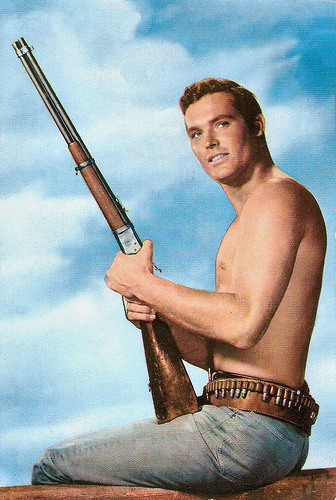
Spanish postcard by Ediciones Este, no. 7 T, 1963. Photo: Warner Bros. Publicity still for the TV series Bronco (1958-1962).
Just a hunk of beefcake
Though born as Orison Whipple Hungerford Jr. (!) in New York City in 1930, Ty Hardin was raised in Texas. His family moved to Austin when he was six months old. His father, an acoustical engineer, left the family four years later.
As a growing boy, his grandmother, with whom he lived part of the time after his parents divorced, nicknamed him 'Ty' because he was as active as a 'Texas typhoon'. Hardin graduated in 1949 from Lamar High School in Houston. A football scholarship enabled him to attend Blinn College in Brenham, Texas for one year, and then he went to Dallas's Bible Institute for one semester.
After military service during the Korean War, Ty took some classes at Texas A&M University in College Station on a football scholarship. He then moved west to California. A Paramount Pictures talent scout discovered him at a costume party. Ty had rented six-guns from a costume rental company.
By 1957, Hardin acquired the services of agent Henry Willson, the man who discovered Rock Hudson, and made his way to Hollywood where he was put under contract by Paramount Pictures. Credited as Ty Hungerford, the handsome blonde won some minor roles in B movies such as I Married a Monster from Outer Space (Gene Fowler Jr., 1958) and The Space Children (Jack Arnold, 1958).
He moved to Warner Brothers, and his stage surname was changed to 'Hardin', reminiscent of the Texas gunfighter John Wesley Hardin. He attended actors' school at Warner Brothers and landed small parts in various Warner productions. In 1958, when TV's Clint Walker insisted on improvements in his Cheyenne contract, Warner Brothers countered by bringing in Ty as a possible replacement.
Warner Bros installed Ty into Cheyenne for the remainder of the season, as the country cousin Bronco Layne. Walker and Warner Brothers came to terms after the season ended, but Hardin had made such a big hit on the show that Jack L. Warner gave him his own series, Bronco. The series alternated weeks with Sugarfoot, starring Will Hutchins, and Cheyenne for four years. The series ran from 1958 to 1962.
From here, he moved into a brief flurry of film activity. Warner Bros cast him as Doug 'Stretch' Fortune in Merrill's Marauders (Samuel Fuller, 1962). It was followed by roles in The Chapman Report (George Cukor, 1962) opposite Glynis Johns , Wall of Noise (Richard Wilson, 1963), and Battle of the Bulge (Ken Annakin, 1965) starring Henry Fonda.
IMDb : "Though often dismissed as just a hunk of 'beefcake' - he did a lot of bare-chest scenes - Ty displayed a flair for light comedy in The Chapman Report (1962) and showed dramatic potential in the underrated Wall of Noise (1963)."
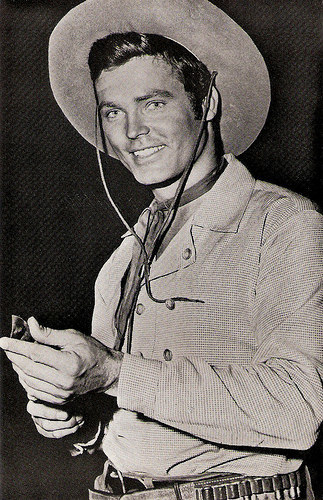
British postcard by D. Constance Ltd., London, in the Celebrity Series, no. 372. Photo: Ty Hardin as Bronco Layne in the TV series Bronco (1959-1962).
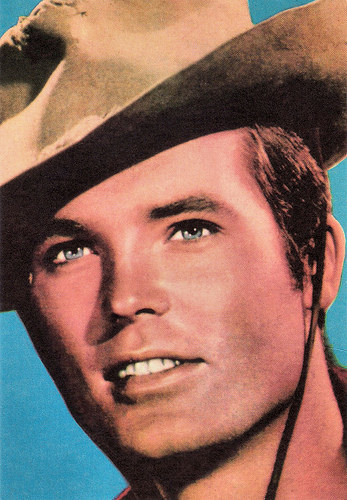
Vintage card.
A penchant for stockpiling weapons and baiting public officials
When his contract expired, Ty Hardin left Hollywood to seek opportunity overseas as his series aired all over the world. Like many other American actors, he travelled to Europe, where he turned down Sergio Leone's offer to play the lead in the classic Per un pugno di dollari/A Fistful of Dollars (1964). In Italy, he did play in the Spaghetti Western L'uomo della valle maledetta/The Man from Cursed Valley (Siro Marcellini, 1964), and the action film Bersaglio mobile/Moving Target (Sergio Corbucci, 1967).
Wikipedia mentions that Hardin was reportedly the first choice to play the starring role in the television series Batman (1966), which went instead to Adam West. Hardin turned down Batman because of film commitments overseas. He did star in the Australian television series Riptide (1967–1968) in which he played an American running a charter boat company along the eastern seaboard of Australia. In 1970 he starred in the popular French-German TV series called Arpad der Zigeuner/Arpad the Gypsy (1973-1974) with Robert Etcheverry.
After his acting career faded away, he worked in Prescott, Arizona, as an evangelistic preacher. According to IMDb , Ty Hardin then became a self-proclaimed 'freedom fighter' in the 1970s, and led a radical right-wing group called The Arizona Patriots, an anti-Semitic/anti-immigrant/anti-black group with a penchant for stockpiling weapons and baiting public officials.
In 1986, following a two-year FBI undercover investigation, agents from the FBI and ATF raided an Arizona Patriot camp and confiscated a hoard of illegal weapons and publications from Aryan Nation groups and affiliates. Hardin left Arizona, and the group soon ceased to function.
Later he incidentally appeared in TV series and films. He had small parts in the American teen film The Zoo Gang (Pen Densham, John Watson, 1985) with Jason Gedrick, and the American coming-of-age adventure action film Rescue Me (Arthur Allan Seidelman, 1992) starring Stephen Dorff. His final film role was s bit part in the romantic comedy Head Over Spurs in Love (Ana Zins, 2011)
On 3 August 2017, Ty Hardin died of Alzheimer disease in Huntington Beach, California, USA. He married eight times, divorced seven times, and had ten children from five of his marriages. From 1962 till 1966, he was married to the 1961 Miss Universe, German beauty queen Marlene Schmidt, who later worked in the film industry; they had one daughter. He also had twin sons with Andra Martin: Jeff Orison and 'John Richard Hardin. At his death, Hardin lived with his eighth wife, Caroline, in Huntington Beach.
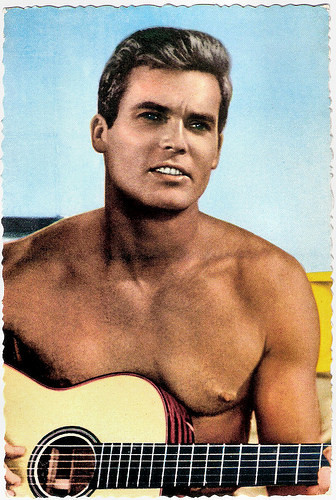
Spanish postcard by Archivo Bermejo, no. C-81, 1963. Photo: Warner Bros. Publicity still for the TV series Bronco (1958-1962).
Source: Les gens du Cinema (French), Wikipedia and .

Spanish postcard by Ediciones Este, no. 7 T, 1963. Photo: Warner Bros. Publicity still for the TV series Bronco (1958-1962).
Just a hunk of beefcake
Though born as Orison Whipple Hungerford Jr. (!) in New York City in 1930, Ty Hardin was raised in Texas. His family moved to Austin when he was six months old. His father, an acoustical engineer, left the family four years later.
As a growing boy, his grandmother, with whom he lived part of the time after his parents divorced, nicknamed him 'Ty' because he was as active as a 'Texas typhoon'. Hardin graduated in 1949 from Lamar High School in Houston. A football scholarship enabled him to attend Blinn College in Brenham, Texas for one year, and then he went to Dallas's Bible Institute for one semester.
After military service during the Korean War, Ty took some classes at Texas A&M University in College Station on a football scholarship. He then moved west to California. A Paramount Pictures talent scout discovered him at a costume party. Ty had rented six-guns from a costume rental company.
By 1957, Hardin acquired the services of agent Henry Willson, the man who discovered Rock Hudson, and made his way to Hollywood where he was put under contract by Paramount Pictures. Credited as Ty Hungerford, the handsome blonde won some minor roles in B movies such as I Married a Monster from Outer Space (Gene Fowler Jr., 1958) and The Space Children (Jack Arnold, 1958).
He moved to Warner Brothers, and his stage surname was changed to 'Hardin', reminiscent of the Texas gunfighter John Wesley Hardin. He attended actors' school at Warner Brothers and landed small parts in various Warner productions. In 1958, when TV's Clint Walker insisted on improvements in his Cheyenne contract, Warner Brothers countered by bringing in Ty as a possible replacement.
Warner Bros installed Ty into Cheyenne for the remainder of the season, as the country cousin Bronco Layne. Walker and Warner Brothers came to terms after the season ended, but Hardin had made such a big hit on the show that Jack L. Warner gave him his own series, Bronco. The series alternated weeks with Sugarfoot, starring Will Hutchins, and Cheyenne for four years. The series ran from 1958 to 1962.
From here, he moved into a brief flurry of film activity. Warner Bros cast him as Doug 'Stretch' Fortune in Merrill's Marauders (Samuel Fuller, 1962). It was followed by roles in The Chapman Report (George Cukor, 1962) opposite Glynis Johns , Wall of Noise (Richard Wilson, 1963), and Battle of the Bulge (Ken Annakin, 1965) starring Henry Fonda.
IMDb : "Though often dismissed as just a hunk of 'beefcake' - he did a lot of bare-chest scenes - Ty displayed a flair for light comedy in The Chapman Report (1962) and showed dramatic potential in the underrated Wall of Noise (1963)."

British postcard by D. Constance Ltd., London, in the Celebrity Series, no. 372. Photo: Ty Hardin as Bronco Layne in the TV series Bronco (1959-1962).

Vintage card.
A penchant for stockpiling weapons and baiting public officials
When his contract expired, Ty Hardin left Hollywood to seek opportunity overseas as his series aired all over the world. Like many other American actors, he travelled to Europe, where he turned down Sergio Leone's offer to play the lead in the classic Per un pugno di dollari/A Fistful of Dollars (1964). In Italy, he did play in the Spaghetti Western L'uomo della valle maledetta/The Man from Cursed Valley (Siro Marcellini, 1964), and the action film Bersaglio mobile/Moving Target (Sergio Corbucci, 1967).
Wikipedia mentions that Hardin was reportedly the first choice to play the starring role in the television series Batman (1966), which went instead to Adam West. Hardin turned down Batman because of film commitments overseas. He did star in the Australian television series Riptide (1967–1968) in which he played an American running a charter boat company along the eastern seaboard of Australia. In 1970 he starred in the popular French-German TV series called Arpad der Zigeuner/Arpad the Gypsy (1973-1974) with Robert Etcheverry.
After his acting career faded away, he worked in Prescott, Arizona, as an evangelistic preacher. According to IMDb , Ty Hardin then became a self-proclaimed 'freedom fighter' in the 1970s, and led a radical right-wing group called The Arizona Patriots, an anti-Semitic/anti-immigrant/anti-black group with a penchant for stockpiling weapons and baiting public officials.
In 1986, following a two-year FBI undercover investigation, agents from the FBI and ATF raided an Arizona Patriot camp and confiscated a hoard of illegal weapons and publications from Aryan Nation groups and affiliates. Hardin left Arizona, and the group soon ceased to function.
Later he incidentally appeared in TV series and films. He had small parts in the American teen film The Zoo Gang (Pen Densham, John Watson, 1985) with Jason Gedrick, and the American coming-of-age adventure action film Rescue Me (Arthur Allan Seidelman, 1992) starring Stephen Dorff. His final film role was s bit part in the romantic comedy Head Over Spurs in Love (Ana Zins, 2011)
On 3 August 2017, Ty Hardin died of Alzheimer disease in Huntington Beach, California, USA. He married eight times, divorced seven times, and had ten children from five of his marriages. From 1962 till 1966, he was married to the 1961 Miss Universe, German beauty queen Marlene Schmidt, who later worked in the film industry; they had one daughter. He also had twin sons with Andra Martin: Jeff Orison and 'John Richard Hardin. At his death, Hardin lived with his eighth wife, Caroline, in Huntington Beach.

Spanish postcard by Archivo Bermejo, no. C-81, 1963. Photo: Warner Bros. Publicity still for the TV series Bronco (1958-1962).
Source: Les gens du Cinema (French), Wikipedia and .
Published on August 06, 2017 22:00
August 5, 2017
Silent films from 100 years ago discovered at recycling centre
In the British town of Sidmouth in Devon, a dozen of rare silent films has been discovered recently in a dumped shelf unit at a recycling centre. Film buffs Mike Grant and his daughter Rachel found the trove with films from France, Italy, India and the UK from circa 1909 to 1913. It also included the MGM-comedy
The Cardboard Lover
(Robert Z. Leonard, 1928), of which only one other copy is known. The films will be donated to the BFI.
Here at EFSP, we love this kind of news, and to celebrate it this post is dedicated to the star of The Cardboard Lover, Marion Davies (1897-1961). The American actress starred in nearly four dozen films between 1917 and 1937, but her once glittering career was later overshadowed by Orson Welles' classic Citizen Kane (1941) which viciously portrayed her as a talentless and sad failure. This year's Il Cinema Ritrovato presented her film The Patsy (1928) at The Piazza Maggiore to an audience of thousands. This delicious, magnificent gem directed by King Vidor showed that Davies was in fact one of the great comedic actresses of the silent era.
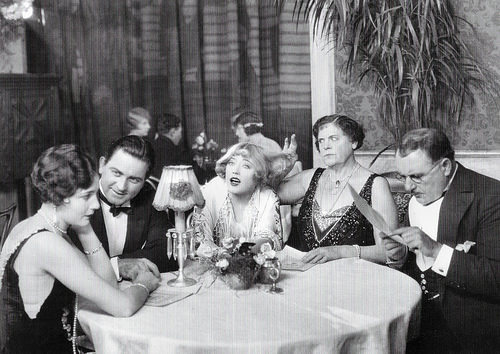
Promotion card for Il Cinema Ritrovato, Bologna, 2017. Photo: publicity still for The Patsy (King Vidor, 1928) with Marion Davies (middle), Jane Winton, Orville Caldwell, Marie Dressler and Dell Henderson.

French postcard by Europe, no. 666. Photo: Goldwyn Mayer.
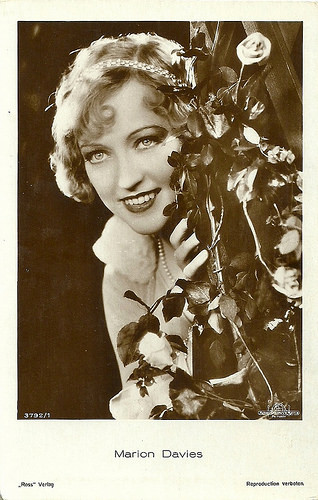
German postcard by Ross Verlag, no. 3732/1, 1928-1929. Photo: Metro-Goldwyn-Mayer.
The famous Ziegfeld Follies
Marion Davies was born Marion Cecelia Douras in the borough of Brooklyn, New York in 1897. She had been bitten by the show biz bug early as she watched her sisters perform in local stage productions. She wanted to do the same.
As Marion got older, she tried out for various school plays and did fairly well. Once her formal education had ended, Marion began her career as a chorus girl in New York City, first in the Pony Follies and eventually in the famous Ziegfeld Follies. Her stage name came when she and her family passed the Davies Insurance Building. One of her sisters called out "Davies!!! That shall be my stage name," and the whole family took on that name.
Marion wanted more than to dance. Acting, to her, was the epitome of show business and she aimed her sights in that direction. She had met newspaper magnate William Randolph Hearst and went to live with him at his San Simeon castle in California. They would stay together for over 30 years, while Hearst’s wife Millicent resided in New York. Millicent would not grant him a divorce so that he could marry Davies.
San Simeon is a spectacular and elaborate mansion, which now stands as a California landmark. At San Simeon, the couple threw elaborate parties, which were frequented by all of the top names in Hollywood and other celebrities including the mayor of New York City, President Calvin Coolidge and Charles Lindbergh.
When she was 20, Marion made her first film, Runaway Romany (George W. Lederer, 1917). Written by Marion and directed by her brother-in-law, the film wasn't exactly a box-office smash, but for Marion, it was a start and a stepping stone to bigger things.
The following year Marion starred in The Burden of Proof (John G. Adolfi, Julius Steger, 1918) and Cecilia of the Pink Roses (Julius Steger, 1918). The latter film was backed by William Randolph Hearst. Because of Hearst's newspaper empire, Marion would be promoted as no actress before her.
She appeared in numerous films over the next few years, including the superior comedy Getting Mary Married (Allan Dwan, 1919) with Norman Kerry, the suspenseful The Cinema Murder (George D. Baker, 1919) and the drama The Restless Sex (Leon D'Usseau, Robert Z. Leonard, 1920) with Carlyle Blackwell.
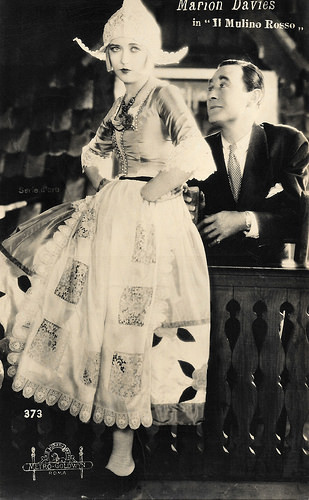
Italian postcard by Casa Editrice Ballerini & Fratini, Firenze (B.F.F. Editore), no. 373. Photo: Metro-Goldwyn, Roma. Publicity still for The Red Mill (Roscoe 'Fatty' Arbuckle (as William Goodrich), 1927) with Owen Moore.
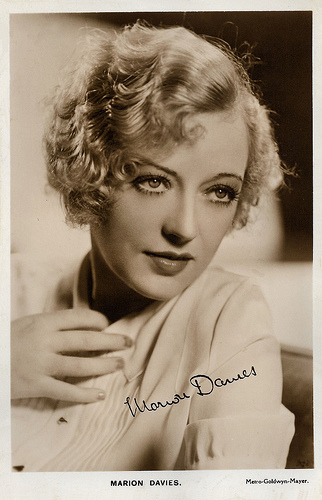
British postcard. Photo: Metro-Goldwyn-Mayer.
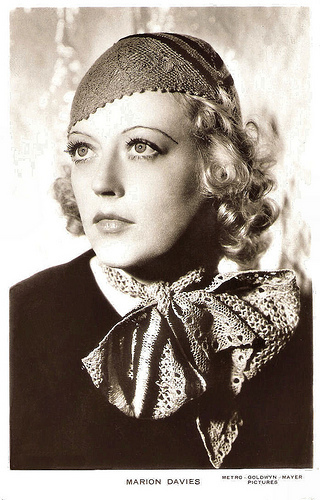
British postcard. Photo: Metro-Goldwyn-Mayer.
A very sharp and savvy business woman
In 1922, Marion Davies appeared as Mary Tudor in the historical romantic epic, When Knighthood Was in Flower (Robert G. Vignola, 1922). It was a film into which Hearst poured millions of dollars as a showcase for her. Although Marion didn't normally appear in period pieces, she turned in a wonderful performance, according to Denny Jackson at IMDb , and the film became a box office hit.
Marion remained busy, one of the staples in cinemas around the country. Time after time, film after film, Marion turned in masterful performances. Her best films were the comedies The Patsy (1928) also with Marie Dressler, and Show People (1929) with William Haines, both directed by King Vidor.
At the end of the 1920s, it was obvious that sound films were about to replace the silent films. Marion was nervous because she had a stutter when she became excited and worried she wouldn't make a successful transition to the new medium. But she was a true professional who had no problem with the change.
In 1930, two of her better films were Not So Dumb (King Vidor, 1930) and The Florodora Girl (Harry Beaumont, 1930), with Lawrence Grant. By the early 1930s, Marion had lost her box office appeal and the downward slide began. Hearst tried to push MGM executives to hire Marion for the role of Elizabeth Barrett in The Barretts of Wimpole Street (Sidney Franklin, 1934). Louis B. Mayer had other ideas and hired producer Irving Thalberg's wife Norma Shearer instead. Hearst reacted by pulling his newspaper support for MGM without much impact.
By the late 1930s Hearst was suffering financial reversals and it was Marion who bailed him out by selling off $1 million of her jewelry. Hearst's financial problems also spelled the end to her career. Although she had made the transition to sound, other stars fared better and her roles became fewer and further between. In 1937, a 40 year old Marion filmed her last movie, Ever Since Eve (Lloyd Bacon, 1937) with Robert Montgomery.
Out of films and with the intense pressures of her relationship with Hearst, Marion turned to more and more to alcohol. Despite those problems, Marion was a very sharp and savvy business woman.
When Hearst lay dying in 1951 at age 88, Davies was given a sedative by his lawyer. When she awoke several hours later, she discovered that Hearst had passed away and that his associates had removed his body as well as all his belongings and any trace that he had lived there with her. His family had a big formal funeral for him in San Francisco, from which she was banned.
Later, Marion married for the first time at the age of 54, to Horace Brown. The union would last until she died of cancer in 1961 in Los Angeles, California. She was 64 years old. Upon Marion’s niece Patricia Van Cleve Lake's death, it was revealed she had been the love child of Davies and Hearst.
The love affair of Marion Davies and Hearst was mirrored in the films Citizen Kane (Orson Welles, 1941), RKO 281 (Benjamin Ross, 1999), and The Cat's Meow (Peter Bogdanovich, 2001). In Citizen Kane (1941), the title character's second wife (played by Dorothy Comingore) — an untalented singer whom he tries to promote — was widely assumed to be based on Davies. But many commentators, including Citizen Kane writer/director Orson Welles himself, have defended Davies' record as a gifted actress, to whom Hearst's patronage did more harm than good.

Italian postcard. Photo: Metro-Goldwyn-Mayer.
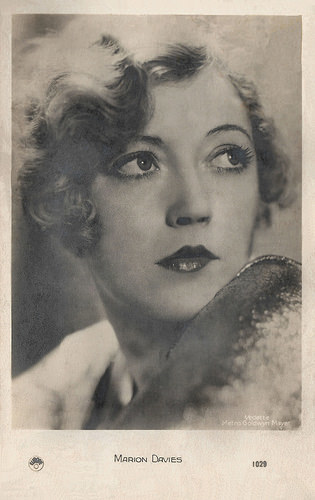
French postcard by Europe, no. 1029. Photo: Metro-Goldwyn-Mayer.
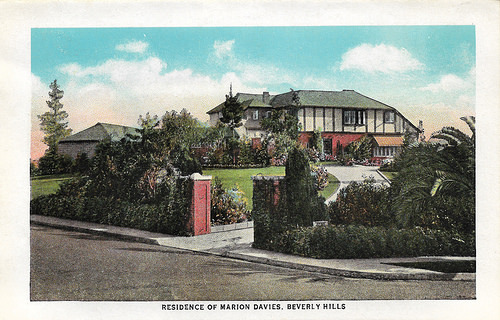
American postcard by C.T. & Co., Chi, in the series Homes of Movie Stars in California. Residence of Marion Davies, Beverly Hills
Sources: Nick Enoch (Mail on Line), (IMDb), Wikipedia and b.
Here at EFSP, we love this kind of news, and to celebrate it this post is dedicated to the star of The Cardboard Lover, Marion Davies (1897-1961). The American actress starred in nearly four dozen films between 1917 and 1937, but her once glittering career was later overshadowed by Orson Welles' classic Citizen Kane (1941) which viciously portrayed her as a talentless and sad failure. This year's Il Cinema Ritrovato presented her film The Patsy (1928) at The Piazza Maggiore to an audience of thousands. This delicious, magnificent gem directed by King Vidor showed that Davies was in fact one of the great comedic actresses of the silent era.

Promotion card for Il Cinema Ritrovato, Bologna, 2017. Photo: publicity still for The Patsy (King Vidor, 1928) with Marion Davies (middle), Jane Winton, Orville Caldwell, Marie Dressler and Dell Henderson.

French postcard by Europe, no. 666. Photo: Goldwyn Mayer.

German postcard by Ross Verlag, no. 3732/1, 1928-1929. Photo: Metro-Goldwyn-Mayer.
The famous Ziegfeld Follies
Marion Davies was born Marion Cecelia Douras in the borough of Brooklyn, New York in 1897. She had been bitten by the show biz bug early as she watched her sisters perform in local stage productions. She wanted to do the same.
As Marion got older, she tried out for various school plays and did fairly well. Once her formal education had ended, Marion began her career as a chorus girl in New York City, first in the Pony Follies and eventually in the famous Ziegfeld Follies. Her stage name came when she and her family passed the Davies Insurance Building. One of her sisters called out "Davies!!! That shall be my stage name," and the whole family took on that name.
Marion wanted more than to dance. Acting, to her, was the epitome of show business and she aimed her sights in that direction. She had met newspaper magnate William Randolph Hearst and went to live with him at his San Simeon castle in California. They would stay together for over 30 years, while Hearst’s wife Millicent resided in New York. Millicent would not grant him a divorce so that he could marry Davies.
San Simeon is a spectacular and elaborate mansion, which now stands as a California landmark. At San Simeon, the couple threw elaborate parties, which were frequented by all of the top names in Hollywood and other celebrities including the mayor of New York City, President Calvin Coolidge and Charles Lindbergh.
When she was 20, Marion made her first film, Runaway Romany (George W. Lederer, 1917). Written by Marion and directed by her brother-in-law, the film wasn't exactly a box-office smash, but for Marion, it was a start and a stepping stone to bigger things.
The following year Marion starred in The Burden of Proof (John G. Adolfi, Julius Steger, 1918) and Cecilia of the Pink Roses (Julius Steger, 1918). The latter film was backed by William Randolph Hearst. Because of Hearst's newspaper empire, Marion would be promoted as no actress before her.
She appeared in numerous films over the next few years, including the superior comedy Getting Mary Married (Allan Dwan, 1919) with Norman Kerry, the suspenseful The Cinema Murder (George D. Baker, 1919) and the drama The Restless Sex (Leon D'Usseau, Robert Z. Leonard, 1920) with Carlyle Blackwell.

Italian postcard by Casa Editrice Ballerini & Fratini, Firenze (B.F.F. Editore), no. 373. Photo: Metro-Goldwyn, Roma. Publicity still for The Red Mill (Roscoe 'Fatty' Arbuckle (as William Goodrich), 1927) with Owen Moore.

British postcard. Photo: Metro-Goldwyn-Mayer.

British postcard. Photo: Metro-Goldwyn-Mayer.
A very sharp and savvy business woman
In 1922, Marion Davies appeared as Mary Tudor in the historical romantic epic, When Knighthood Was in Flower (Robert G. Vignola, 1922). It was a film into which Hearst poured millions of dollars as a showcase for her. Although Marion didn't normally appear in period pieces, she turned in a wonderful performance, according to Denny Jackson at IMDb , and the film became a box office hit.
Marion remained busy, one of the staples in cinemas around the country. Time after time, film after film, Marion turned in masterful performances. Her best films were the comedies The Patsy (1928) also with Marie Dressler, and Show People (1929) with William Haines, both directed by King Vidor.
At the end of the 1920s, it was obvious that sound films were about to replace the silent films. Marion was nervous because she had a stutter when she became excited and worried she wouldn't make a successful transition to the new medium. But she was a true professional who had no problem with the change.
In 1930, two of her better films were Not So Dumb (King Vidor, 1930) and The Florodora Girl (Harry Beaumont, 1930), with Lawrence Grant. By the early 1930s, Marion had lost her box office appeal and the downward slide began. Hearst tried to push MGM executives to hire Marion for the role of Elizabeth Barrett in The Barretts of Wimpole Street (Sidney Franklin, 1934). Louis B. Mayer had other ideas and hired producer Irving Thalberg's wife Norma Shearer instead. Hearst reacted by pulling his newspaper support for MGM without much impact.
By the late 1930s Hearst was suffering financial reversals and it was Marion who bailed him out by selling off $1 million of her jewelry. Hearst's financial problems also spelled the end to her career. Although she had made the transition to sound, other stars fared better and her roles became fewer and further between. In 1937, a 40 year old Marion filmed her last movie, Ever Since Eve (Lloyd Bacon, 1937) with Robert Montgomery.
Out of films and with the intense pressures of her relationship with Hearst, Marion turned to more and more to alcohol. Despite those problems, Marion was a very sharp and savvy business woman.
When Hearst lay dying in 1951 at age 88, Davies was given a sedative by his lawyer. When she awoke several hours later, she discovered that Hearst had passed away and that his associates had removed his body as well as all his belongings and any trace that he had lived there with her. His family had a big formal funeral for him in San Francisco, from which she was banned.
Later, Marion married for the first time at the age of 54, to Horace Brown. The union would last until she died of cancer in 1961 in Los Angeles, California. She was 64 years old. Upon Marion’s niece Patricia Van Cleve Lake's death, it was revealed she had been the love child of Davies and Hearst.
The love affair of Marion Davies and Hearst was mirrored in the films Citizen Kane (Orson Welles, 1941), RKO 281 (Benjamin Ross, 1999), and The Cat's Meow (Peter Bogdanovich, 2001). In Citizen Kane (1941), the title character's second wife (played by Dorothy Comingore) — an untalented singer whom he tries to promote — was widely assumed to be based on Davies. But many commentators, including Citizen Kane writer/director Orson Welles himself, have defended Davies' record as a gifted actress, to whom Hearst's patronage did more harm than good.

Italian postcard. Photo: Metro-Goldwyn-Mayer.

French postcard by Europe, no. 1029. Photo: Metro-Goldwyn-Mayer.

American postcard by C.T. & Co., Chi, in the series Homes of Movie Stars in California. Residence of Marion Davies, Beverly Hills
Sources: Nick Enoch (Mail on Line), (IMDb), Wikipedia and b.
Published on August 05, 2017 22:00
August 4, 2017
Vom Werden deutscher Filmkunst, Part 1
Recently, we acquired at eBay a package with collectors cards by Ross Verlag called Vom Werden deutscher Filmkunst. The title translates as From the becoming of German film art. Some of the cards are smaller than postcards, others bigger. On the collectors cards of this series (no. 10) are pictures of the German silent cinema. Collectors could glue them in an album called 'Der Stumme Film' (The Silent Film) written by Dr. Oskar Kalbus. Another volume treats the German sound film. This series includes star portraits and film scenes, but also pictures of film sets and curiosities like for instance a bust of Asta Nielsen in her famous and controversial role as Hamlet.
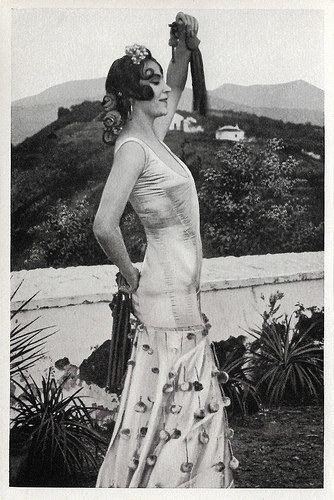
Asta Nielsen in Der Tod von Sevilla (1913). German collectors card by Ross Verlag in the series Vom Werden Deutscher Filmkunst - Der Stumme Film, no. 6, group 43. Photo: publicity still for Der Tod von Sevilla/The death of Seville (Urban Gad, 1913).
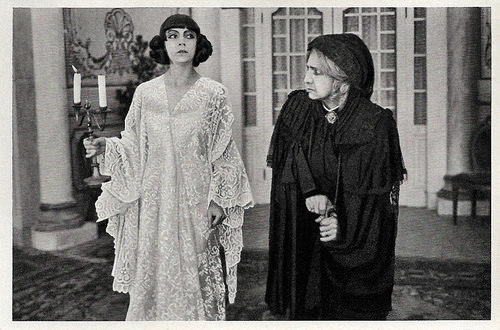
Asta Nielsen and Mary Scheller in Das Feuer (1914). German collectors card by Ross Verlag in the series Vom Werden Deutscher Filmkunst - Der Stumme Film, picture no. 7, group 43. Photo: publicity still for Das Feuer/The Fire (Urban Gad, 1914).
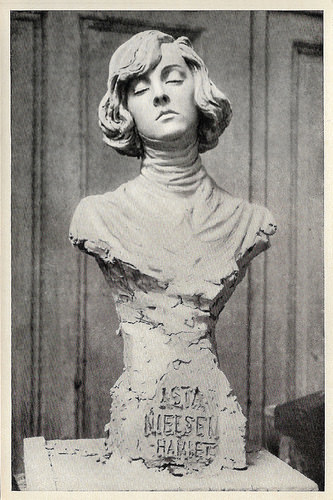
Asta Nielsen . German collectors card by Ross Verlag in the series Vom Werden Deutscher Filmkunst - Der Stumme Film, picture no. 8. Photo: Bust of Asta Nielsen as Hamlet.
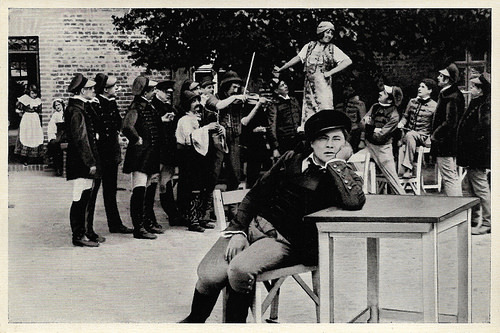
Paul Wegener and Lyda Salmonova in Der Student von Prag (1913). German collectors card by Ross Verlag in the series Vom Werden Deutscher Filmkunst - Der Stumme Film, picture no. 9. Photo: Sokal-Film. Publicity still for Der Student von Prag/The Student of Prague (Paul Wegener, Stellan Rye, 1913).
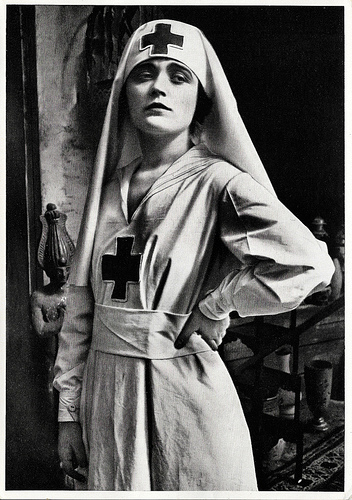
Pola Negri in Vendetta (1919). German collectors card by Ross Verlag in the series Vom Werden Deutscher Filmkunst - Der Stumme Film, picture no. 10, group 40. Photo: Ufa. Publicity still with Pola Negri as nurse in Vendetta (Georg Jacoby, 1919).
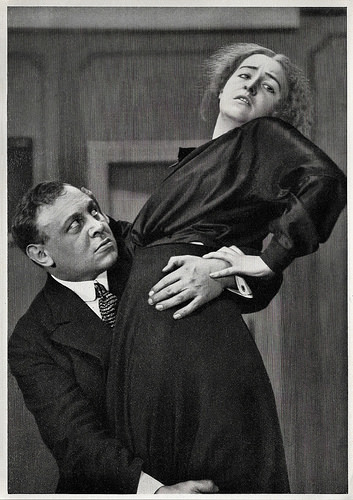
Emil Jannings and Henny Porten in Die Ehe der Luise Rohrbach (1917). German collectors card by Ross Verlag in the series Vom Werden Deutscher Filmkunst - Der Stumme Film, picture no. 12, group 40. Photo: Ufa. Publicity still for Die Ehe der Luise Rohrbach/The Marriage of Luise Rohrbach (Rudolf Biebrach, 1917).
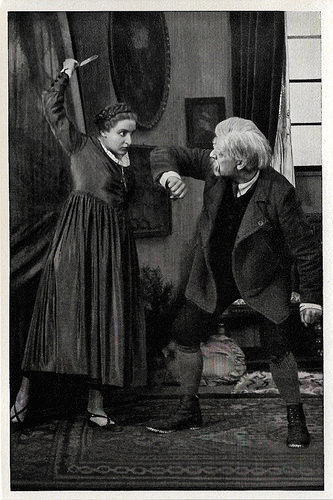
Henny Porten and Rudolf Biebrach in Das Geschlecht derer von Ringwall (1918). German collectors card by Ross Verlag in the series Vom Werden Deutscher Filmkunst - Der Stumme Film, picture no. 13, group 43. Photo: Messter-Film. Publicity still for Das Geschlecht derer von Ringwall/The Ringwall family (Rudolf Biebrach, 1918).
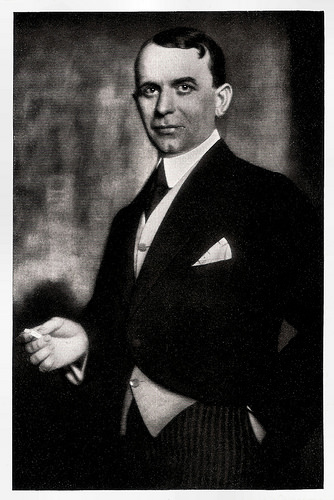
Viggo Larsen. German collectors card by Ross Verlag in the series Vom Werden Deutscher Filmkunst - Der Stumme Film, picture no. 16, group 43. Photo: Karl Schenker.
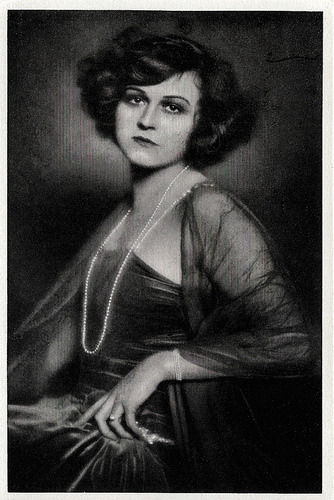
Hanni Weisse . German collectors card by Ross Verlag in the series Vom Werden Deutscher Filmkunst - Der Stumme Film, picture no. 18, group 43. Photo: Balázs.
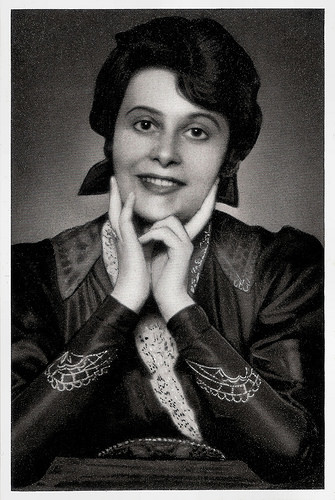
Wanda Treumann . German collectors card by Ross Verlag in the series Vom Werden Deutscher Filmkunst - Der Stumme Film, picture no. 20, group 43. Photo: Karl Schenker. Caption: "Wanda Treumann, for years the partner of Viggo Larsen".

Maria Carmi and Carl de Vogt in Der Weg des Todes (1916). German collectors card by Ross Verlag in the series Vom Werden Deutscher Filmkunst - Der Stumme Film, picture no. 23, group 43. Photo: Ufa. Publicity still for Der Weg des Todes/The Road of Death (Robert Reinert, 1916).
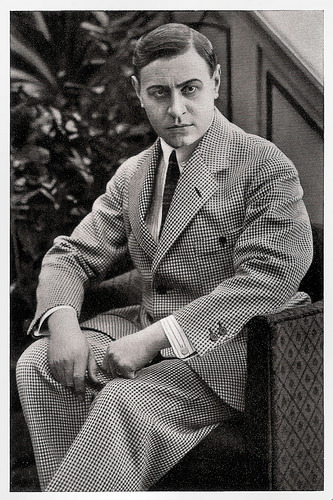
Emil Jannings in Fromont Junior, Risler Senior a.k.a. Frau Eva (1915-1916). German collectors card by Ross Verlag in the series Vom Werden Deutscher Filmkunst - Der Stumme Film, picture no, 29, group 43. Photo: publicity still for Arme Eva (Robert Wiene, 1914). Caption: Emil Jannings , young and handsome, in his first film Fromont junior, Risler senior. According to other sources Arme Eva (Robert Wiene, 1914) featuring Erna Morena , was his first film. IMDb mentions two Eva-films, both by Wiene and both starring Morena and Jannings: Arme Eva (1914) and Frau Eva (1916) - a sequel, a remake or just the same film? However, IMDb mentions that the second was based on a play by Alphonse Daudet! And yes, Revolvy confirms: "It was based on the 1874 novel Fromont and Risler by Alphonse Daudet." And at the German Early Film Database and Filmportal.de, there is no mention of Arme Eva, just Frau Eva (1915-1916). At Filmportal.de this picture illustrates the film page...
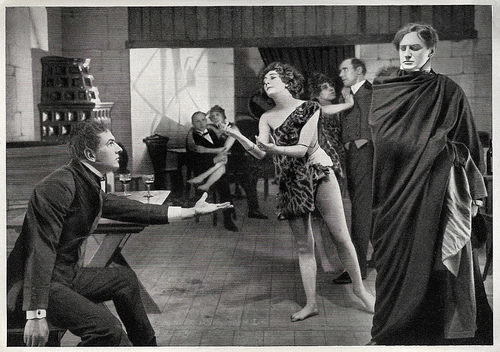
Bruno Decarli , Carmen Mara and Harry Liedtke in Rebellenliebe (1919). German collectors card by Ross Verlag in the series Vom Werden Deutscher Filmkunst - Der Stumme Film, picture no. 30, group 40. Photo: Frankfurter Film-Co. Publicity still for Rebellenliebe/Rebel Love (Karl Heiland, 1919).
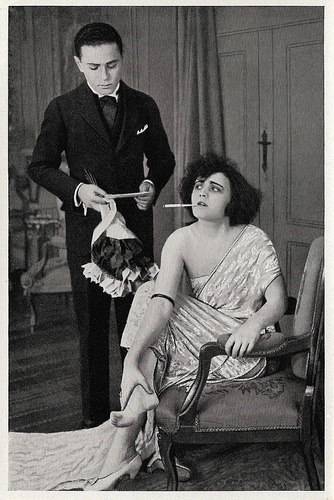
Pola Negri and Fritz Schulz in Die Marchesa d'Armiani (1920). German collectors card by Ross Verlag in the series Vom Werden Deutscher Filmkunst - Der Stumme Film, picture no. 34, group 43. Photo: Union-Film. Publicity still for Die Marchesa d'Armiani (Alfred Halm, 1920).
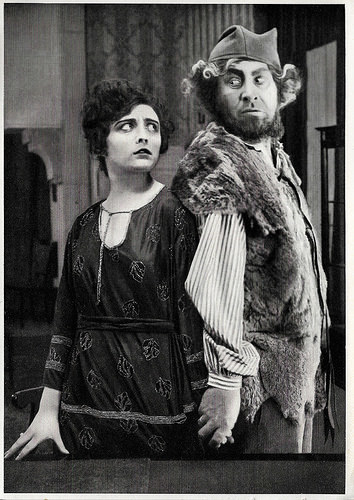
Pola Negri and Emil Jannings in Vendetta (1919). German collectors card by Ross Verlag in the series Vom Werden Deutscher Filmkunst - Der Stumme Film, picture no. 10, group 40. Photo: Ufa. Publicity still for Vendetta (Georg Jacoby, 1919).
To be continued next Saturday!

Asta Nielsen in Der Tod von Sevilla (1913). German collectors card by Ross Verlag in the series Vom Werden Deutscher Filmkunst - Der Stumme Film, no. 6, group 43. Photo: publicity still for Der Tod von Sevilla/The death of Seville (Urban Gad, 1913).

Asta Nielsen and Mary Scheller in Das Feuer (1914). German collectors card by Ross Verlag in the series Vom Werden Deutscher Filmkunst - Der Stumme Film, picture no. 7, group 43. Photo: publicity still for Das Feuer/The Fire (Urban Gad, 1914).

Asta Nielsen . German collectors card by Ross Verlag in the series Vom Werden Deutscher Filmkunst - Der Stumme Film, picture no. 8. Photo: Bust of Asta Nielsen as Hamlet.

Paul Wegener and Lyda Salmonova in Der Student von Prag (1913). German collectors card by Ross Verlag in the series Vom Werden Deutscher Filmkunst - Der Stumme Film, picture no. 9. Photo: Sokal-Film. Publicity still for Der Student von Prag/The Student of Prague (Paul Wegener, Stellan Rye, 1913).

Pola Negri in Vendetta (1919). German collectors card by Ross Verlag in the series Vom Werden Deutscher Filmkunst - Der Stumme Film, picture no. 10, group 40. Photo: Ufa. Publicity still with Pola Negri as nurse in Vendetta (Georg Jacoby, 1919).

Emil Jannings and Henny Porten in Die Ehe der Luise Rohrbach (1917). German collectors card by Ross Verlag in the series Vom Werden Deutscher Filmkunst - Der Stumme Film, picture no. 12, group 40. Photo: Ufa. Publicity still for Die Ehe der Luise Rohrbach/The Marriage of Luise Rohrbach (Rudolf Biebrach, 1917).

Henny Porten and Rudolf Biebrach in Das Geschlecht derer von Ringwall (1918). German collectors card by Ross Verlag in the series Vom Werden Deutscher Filmkunst - Der Stumme Film, picture no. 13, group 43. Photo: Messter-Film. Publicity still for Das Geschlecht derer von Ringwall/The Ringwall family (Rudolf Biebrach, 1918).

Viggo Larsen. German collectors card by Ross Verlag in the series Vom Werden Deutscher Filmkunst - Der Stumme Film, picture no. 16, group 43. Photo: Karl Schenker.

Hanni Weisse . German collectors card by Ross Verlag in the series Vom Werden Deutscher Filmkunst - Der Stumme Film, picture no. 18, group 43. Photo: Balázs.

Wanda Treumann . German collectors card by Ross Verlag in the series Vom Werden Deutscher Filmkunst - Der Stumme Film, picture no. 20, group 43. Photo: Karl Schenker. Caption: "Wanda Treumann, for years the partner of Viggo Larsen".

Maria Carmi and Carl de Vogt in Der Weg des Todes (1916). German collectors card by Ross Verlag in the series Vom Werden Deutscher Filmkunst - Der Stumme Film, picture no. 23, group 43. Photo: Ufa. Publicity still for Der Weg des Todes/The Road of Death (Robert Reinert, 1916).

Emil Jannings in Fromont Junior, Risler Senior a.k.a. Frau Eva (1915-1916). German collectors card by Ross Verlag in the series Vom Werden Deutscher Filmkunst - Der Stumme Film, picture no, 29, group 43. Photo: publicity still for Arme Eva (Robert Wiene, 1914). Caption: Emil Jannings , young and handsome, in his first film Fromont junior, Risler senior. According to other sources Arme Eva (Robert Wiene, 1914) featuring Erna Morena , was his first film. IMDb mentions two Eva-films, both by Wiene and both starring Morena and Jannings: Arme Eva (1914) and Frau Eva (1916) - a sequel, a remake or just the same film? However, IMDb mentions that the second was based on a play by Alphonse Daudet! And yes, Revolvy confirms: "It was based on the 1874 novel Fromont and Risler by Alphonse Daudet." And at the German Early Film Database and Filmportal.de, there is no mention of Arme Eva, just Frau Eva (1915-1916). At Filmportal.de this picture illustrates the film page...

Bruno Decarli , Carmen Mara and Harry Liedtke in Rebellenliebe (1919). German collectors card by Ross Verlag in the series Vom Werden Deutscher Filmkunst - Der Stumme Film, picture no. 30, group 40. Photo: Frankfurter Film-Co. Publicity still for Rebellenliebe/Rebel Love (Karl Heiland, 1919).

Pola Negri and Fritz Schulz in Die Marchesa d'Armiani (1920). German collectors card by Ross Verlag in the series Vom Werden Deutscher Filmkunst - Der Stumme Film, picture no. 34, group 43. Photo: Union-Film. Publicity still for Die Marchesa d'Armiani (Alfred Halm, 1920).

Pola Negri and Emil Jannings in Vendetta (1919). German collectors card by Ross Verlag in the series Vom Werden Deutscher Filmkunst - Der Stumme Film, picture no. 10, group 40. Photo: Ufa. Publicity still for Vendetta (Georg Jacoby, 1919).
To be continued next Saturday!
Published on August 04, 2017 22:00
August 3, 2017
Claire Bloom
Becoming and dark-haired Claire Bloom (1931) is a British actress whose photogenic, slightly pinched beauty was accented by an effortless elegance and poise. Her part in Charlie Chaplin’s Limelight (1952) catapulted Bloom to stardom. Since then she has been lauded several times for her roles on stage, TV and in the cinema.
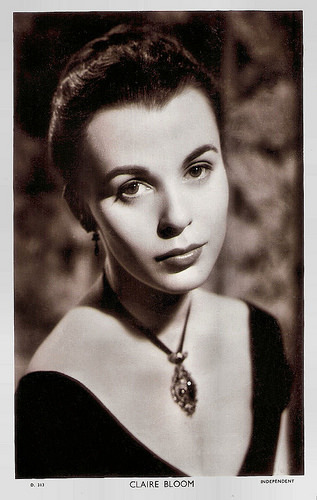
British postcard in the Picturegoer Series, no. D 313. Photo: Independent.
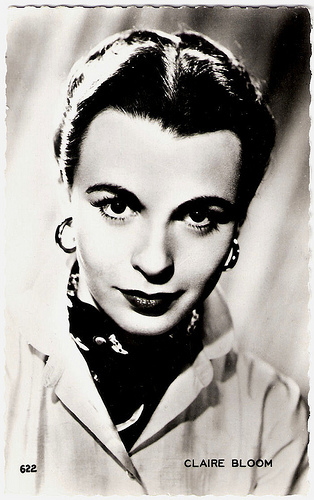
French postcard by Editions P.I., Paris, no. 622, offered by Les carbones Korès 'Carboplane'.
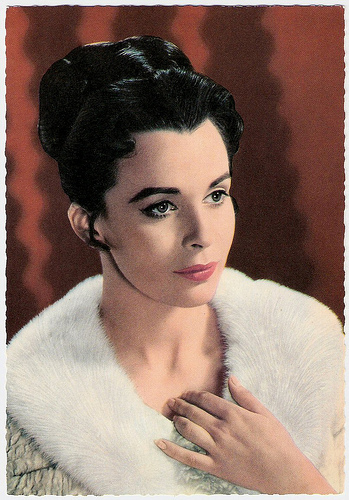
German postcard by ISV, no. B 18. Photo: publicity still for The Brothers Karamazov (Richard Brooks, 1958).
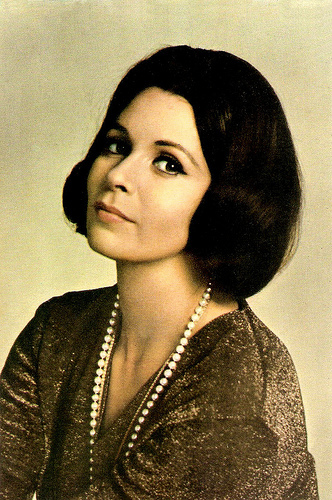
Israelian postcard by Editions de Luxe, no. 127.
Exquisitely touching
Claire Bloom was born Patricia Claire Blume in the North London suburb of Finchley, in 1931. She was the daughter of Elizabeth Grew and Edward Max Blume, who worked in sales. Her paternal grandparents, originally named Blumenthal, as well as her maternal grandparents, originally named Griewski, were Jewish immigrants from Eastern Europe.
Bloom attended secondary school at the independent Badminton School in Bristol. When she was 15, she made her professional debut on the BBC radio. Subsequently she took her first curtain call with the Oxford Repertory Theatre in 1946 in the production of It Depends What You Mean.
From 1946 till 1948 she trained for the stage with Eileen Thorndike at the Guildhall School of Music and Drama. She also attended the Central School of Speech and Drama in 1947 and 1948.
Her London stage debut was in 1947 in the hit play The Lady's Not For Burning, which also featured the young Richard Burton . The following year, she received great acclaim for her portrayal of Ophelia in a Stratford-upon-Avon production of Hamlet, opposite alternating Paul Scofield and Robert Helpmann . Hamlet was the first of many works by William Shakespeare in which Bloom would appear.
Her first film role was a lead in the British courtroom film drama The Blind Goddess (Harold French, 1948) with Eric Portman and Anne Crawford.
In 1952 she was chosen by Charlie Chaplin to appear in his film Limelight (Charles Chaplin, 1952). Her bravura turn as the young suicidal ballerina Terry saved from despair by an ageing music hall clown (Chaplin) was exquisitely touching. Limelight catapulted Bloom to stardom, and remains one of her most memorable roles.
She was subsequently featured in a number of costume roles in films such as Laurence Olivier's film version of Richard III (Laurence Olivier, 1955), Alexander the Great (Robert Rossen, 1956) with Richard Burton , The Brothers Karamazov (Richard Brooks, 1958), The Buccaneer (Anthony Quinn, 1958) with Yul Brynner , and The Wonderful World of the Brothers Grimm (Henry Levin, George Pal, 1962) starring Laurence Harvey .
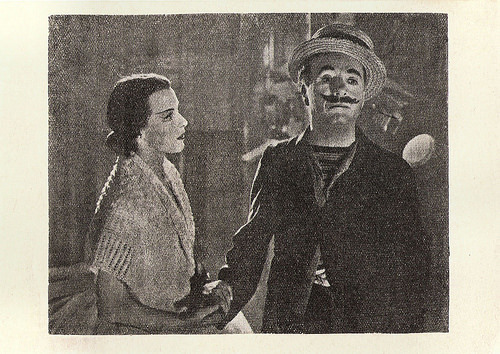
Italian card. Photo: publicity still for Limelight (Charles Chaplin, 1952) with Charlie Chaplin .
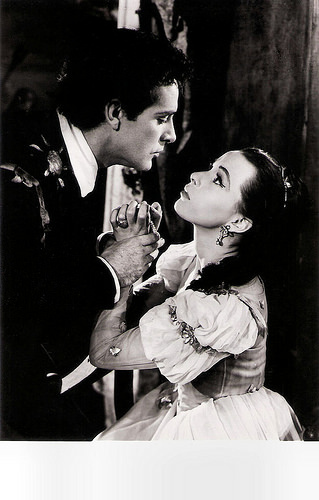
Danish postcard by Kaj Brammers Boghandel, Helsingor, no. 748. Photo: publicity still for the stage production of Hamlet at the Hamletspillene in Kronborg, 1954. Richard Burton as Hamlet and Claire Bloom as Ophelia.
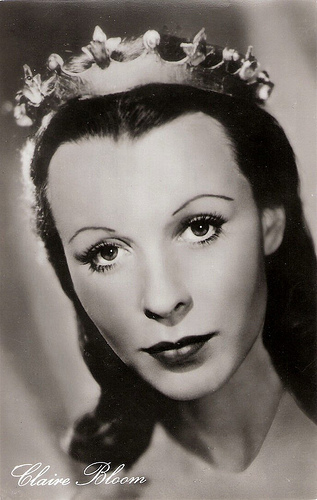
East-German postcard by VEB Progress Film-Vertrieb, Berlin, no. 1110. Photo: publicity still for Richard III (Laurence Olivier, 1955).
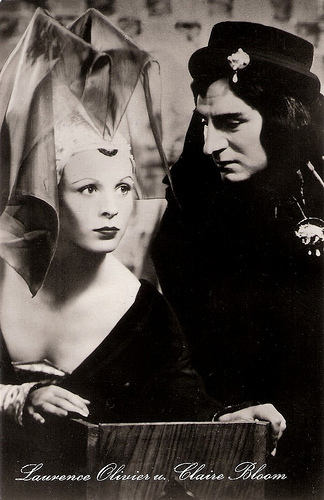
East-German postcard by VEB Progress Film-Vertrieb, Berlin, no. 1099. Photo: publicity still for Richard III (Laurence Olivier, 1955) with Laurence Olivier .
The star-crossed lover role
Despite her new film career, Claire Bloom continued to appear on the Shakespearean stage. "Joining the Old Vic Company for the 1952-1953 and 1953-1954 seasons, she played Helena, Viola, Juliet, Jessica, Miranda, Virgilia (in Coriolanus), Cordelia (in King Lear) and (again) Ophelia in a highly successful tenure", notes Gary Brumburgh at IMDb . "Touring Canada and the United States as Juliet, she made her Broadway bow in the star-crossed lover role in 1956, also playing the Queen in Richard II."
Over the years, she was a strong presence on both the West End and Broadway. Her other memorable stage roles included parts in The Trojan Women, Vivat! Vivat! Regina!, Hedda Gabler, A Doll's House and A Streetcar Named Desire.
In the cinema Bloom began to play contemporary film roles, including Look Back in Anger (Tony Richardson, 1959) and The Spy Who Came in from the Cold (Martin Ritt, 1965), both with Richard Burton. She also played a sexually unstable housewife in The Chapman Report (George Cukor, 1962), the lesbian psychic Theodora in The Haunting (Robert Wise, 1963), and a compassionate psychologist in the Oscar winning film Charly (Ralph Nelson, 1968).
On television she appeared in two prominent BBC Television productions: co-starring with Sean Connery in Anna Karenina (Rudolph Cartier, 1961), and playing Cathy in Wuthering Heights (Rudolph Cartier, 1962) with Keith Michell as Heathcliff. Later she also appeared as First Lady Edith Wilson in Backstairs at the White House (Michael O'Herlihy, 1979).
Whenever her schedule allowed it, Bloom returned to the theatre. According to Gary Brumburgh, her favourite stage role is Blanche DuBois in A Streetcar Named Desire. Bloom also kept appearing on TV, memorably as Lady Marchmain in Brideshead Revisited (Charles Sturridge, Michael Lindsay-Hogg, 1981), for which she was nominated for an Emmy.
She also appeared in a remake of Terence Rattigan's Separate Tables (John Schlesinger, 1983) starring Julie Christie , in the epic miniseries Ellis Island (Jerry London, 1984), and in Philip Roth's acclaimed adaptations of The Ghost Writer (Tristram Powell, 1984) and Shadowlands (Norman Stone, 1985), in which she played Joy Gresham, the wife of C.S. Lewis. For this performance she received the BAFTA Award as Best Actress.
Claire Bloom also appeared in Stephen Frears’ film Sammy and Rosie Get Laid (1987) and the Woody Allen comedies Crimes and Misdemeanors (1989) as Martin Landau's Jewish-suburbanite wife, and Mighty Aphrodite (1995) as Helena Bonham Carter’s mother.
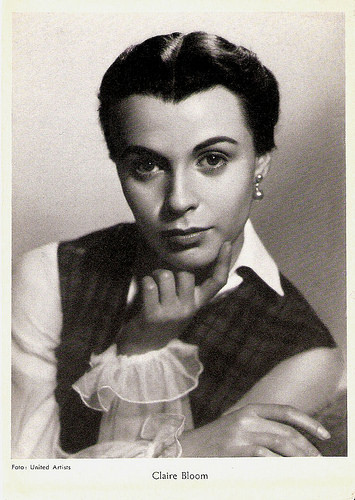
German collectors card. Photo: United Artists.
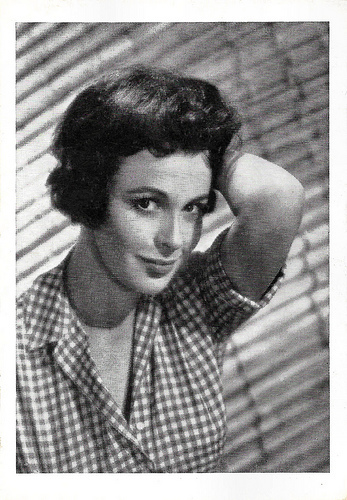
German collectors card.
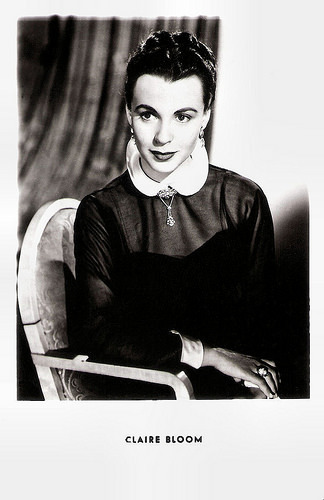
German postcard by Netter's Star Verlag, Berlin, no. A 842.
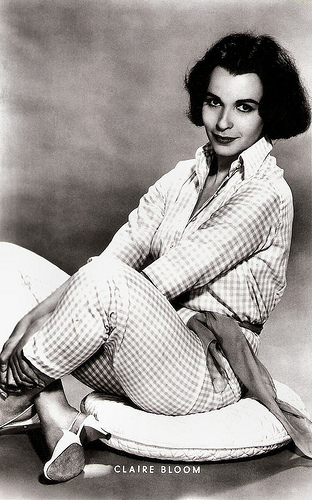
German postcard by Netter's Star Verlag, Berlin, no. A 1593.
Leaving A Doll's House
In the 21st Century, Claire Bloom kept enjoying a full and productive career. She appeared in the TV mini-series The Ten Commandments (Robert Dornhelm, 2006). Later she played in the British series Doctor Who (2009) about the adventures of the time travelling alien adventurer and his companions, and The Bill (2010) about the work of uniformed officers and detectives from a London police station.
In the cinema she was seen as Queen Mary in the four Academy Awards winning box office hit The King's Speech (Tom Hooper, 2010) featuring Colin Firth, and in the drama Max Rose (Daniel Noah, 2013), starring Jerry Lewis.
Her more recent TV work included guest roles in the British comedy-drama series Doc Martin (2013) with Martin Clunes, and the popular British mystery series Midsomer Murders (2015). Currently she is filming the feature Miss Dalí (Ventura Pons, 2017) with Sian Philips.
Bloom has married three times. Her first marriage, in 1959, was to actor Rod Steiger, whom she had met when they both performed in the play Rashomon. Their daughter is opera singer Anna Steiger, Bloom's only child. Steiger and Bloom divorced in 1969.
In that same year, Bloom married producer Hillard Elkins. The marriage lasted three years and the couple divorced in 1972.
Bloom's third marriage in 1990 was to writer Philip Roth, her longtime companion. The couple divorced in 1995. Bloom has written two memoirs about her life and career. The first, Limelight and After: The Education of an Actress, was released in 1982 and was an in-depth look at her career and the film and stage roles she had portrayed.
Her second book, Leaving a Doll's House: A Memoir, was published in 1996, and went into greater details about her personal life; she discussed not only her marriages but her romantic relationships with Richard Burton and Laurence Olivier . Bloom also detailed the highly complicated relationship between her and Philip Roth during their marriage. The details Bloom shared were unflattering to Roth, and created a controversy regarding the true nature of their relationship. The character of Eve Frame in Roth's 1998 novel I Married a Communist is considered by some to be his veiled rebuttal to some of the accusations made against him in her memoir.
In 2013, Claire Bloom was appointed Commander of the Order of the British Empire (CBE) in the Birthday Honours for services to drama.
Trailer Limelight (1952). Source: Cinemusic7888 (YouTube).
Trailer The Brothers Karamazov (1958). Source: Video Detective (YouTube).
Trailer The Haunting (1963). Source: Cherry Movies (YouTube).
Trailer The Spy Who Came in From the Cold (1965). Source: _ XYZT (YouTube).
Sources: Hal Erickson (AllMovie), (IMDb), Film Reference, Wikipedia and .

British postcard in the Picturegoer Series, no. D 313. Photo: Independent.

French postcard by Editions P.I., Paris, no. 622, offered by Les carbones Korès 'Carboplane'.

German postcard by ISV, no. B 18. Photo: publicity still for The Brothers Karamazov (Richard Brooks, 1958).

Israelian postcard by Editions de Luxe, no. 127.
Exquisitely touching
Claire Bloom was born Patricia Claire Blume in the North London suburb of Finchley, in 1931. She was the daughter of Elizabeth Grew and Edward Max Blume, who worked in sales. Her paternal grandparents, originally named Blumenthal, as well as her maternal grandparents, originally named Griewski, were Jewish immigrants from Eastern Europe.
Bloom attended secondary school at the independent Badminton School in Bristol. When she was 15, she made her professional debut on the BBC radio. Subsequently she took her first curtain call with the Oxford Repertory Theatre in 1946 in the production of It Depends What You Mean.
From 1946 till 1948 she trained for the stage with Eileen Thorndike at the Guildhall School of Music and Drama. She also attended the Central School of Speech and Drama in 1947 and 1948.
Her London stage debut was in 1947 in the hit play The Lady's Not For Burning, which also featured the young Richard Burton . The following year, she received great acclaim for her portrayal of Ophelia in a Stratford-upon-Avon production of Hamlet, opposite alternating Paul Scofield and Robert Helpmann . Hamlet was the first of many works by William Shakespeare in which Bloom would appear.
Her first film role was a lead in the British courtroom film drama The Blind Goddess (Harold French, 1948) with Eric Portman and Anne Crawford.
In 1952 she was chosen by Charlie Chaplin to appear in his film Limelight (Charles Chaplin, 1952). Her bravura turn as the young suicidal ballerina Terry saved from despair by an ageing music hall clown (Chaplin) was exquisitely touching. Limelight catapulted Bloom to stardom, and remains one of her most memorable roles.
She was subsequently featured in a number of costume roles in films such as Laurence Olivier's film version of Richard III (Laurence Olivier, 1955), Alexander the Great (Robert Rossen, 1956) with Richard Burton , The Brothers Karamazov (Richard Brooks, 1958), The Buccaneer (Anthony Quinn, 1958) with Yul Brynner , and The Wonderful World of the Brothers Grimm (Henry Levin, George Pal, 1962) starring Laurence Harvey .

Italian card. Photo: publicity still for Limelight (Charles Chaplin, 1952) with Charlie Chaplin .

Danish postcard by Kaj Brammers Boghandel, Helsingor, no. 748. Photo: publicity still for the stage production of Hamlet at the Hamletspillene in Kronborg, 1954. Richard Burton as Hamlet and Claire Bloom as Ophelia.

East-German postcard by VEB Progress Film-Vertrieb, Berlin, no. 1110. Photo: publicity still for Richard III (Laurence Olivier, 1955).

East-German postcard by VEB Progress Film-Vertrieb, Berlin, no. 1099. Photo: publicity still for Richard III (Laurence Olivier, 1955) with Laurence Olivier .
The star-crossed lover role
Despite her new film career, Claire Bloom continued to appear on the Shakespearean stage. "Joining the Old Vic Company for the 1952-1953 and 1953-1954 seasons, she played Helena, Viola, Juliet, Jessica, Miranda, Virgilia (in Coriolanus), Cordelia (in King Lear) and (again) Ophelia in a highly successful tenure", notes Gary Brumburgh at IMDb . "Touring Canada and the United States as Juliet, she made her Broadway bow in the star-crossed lover role in 1956, also playing the Queen in Richard II."
Over the years, she was a strong presence on both the West End and Broadway. Her other memorable stage roles included parts in The Trojan Women, Vivat! Vivat! Regina!, Hedda Gabler, A Doll's House and A Streetcar Named Desire.
In the cinema Bloom began to play contemporary film roles, including Look Back in Anger (Tony Richardson, 1959) and The Spy Who Came in from the Cold (Martin Ritt, 1965), both with Richard Burton. She also played a sexually unstable housewife in The Chapman Report (George Cukor, 1962), the lesbian psychic Theodora in The Haunting (Robert Wise, 1963), and a compassionate psychologist in the Oscar winning film Charly (Ralph Nelson, 1968).
On television she appeared in two prominent BBC Television productions: co-starring with Sean Connery in Anna Karenina (Rudolph Cartier, 1961), and playing Cathy in Wuthering Heights (Rudolph Cartier, 1962) with Keith Michell as Heathcliff. Later she also appeared as First Lady Edith Wilson in Backstairs at the White House (Michael O'Herlihy, 1979).
Whenever her schedule allowed it, Bloom returned to the theatre. According to Gary Brumburgh, her favourite stage role is Blanche DuBois in A Streetcar Named Desire. Bloom also kept appearing on TV, memorably as Lady Marchmain in Brideshead Revisited (Charles Sturridge, Michael Lindsay-Hogg, 1981), for which she was nominated for an Emmy.
She also appeared in a remake of Terence Rattigan's Separate Tables (John Schlesinger, 1983) starring Julie Christie , in the epic miniseries Ellis Island (Jerry London, 1984), and in Philip Roth's acclaimed adaptations of The Ghost Writer (Tristram Powell, 1984) and Shadowlands (Norman Stone, 1985), in which she played Joy Gresham, the wife of C.S. Lewis. For this performance she received the BAFTA Award as Best Actress.
Claire Bloom also appeared in Stephen Frears’ film Sammy and Rosie Get Laid (1987) and the Woody Allen comedies Crimes and Misdemeanors (1989) as Martin Landau's Jewish-suburbanite wife, and Mighty Aphrodite (1995) as Helena Bonham Carter’s mother.

German collectors card. Photo: United Artists.

German collectors card.

German postcard by Netter's Star Verlag, Berlin, no. A 842.

German postcard by Netter's Star Verlag, Berlin, no. A 1593.
Leaving A Doll's House
In the 21st Century, Claire Bloom kept enjoying a full and productive career. She appeared in the TV mini-series The Ten Commandments (Robert Dornhelm, 2006). Later she played in the British series Doctor Who (2009) about the adventures of the time travelling alien adventurer and his companions, and The Bill (2010) about the work of uniformed officers and detectives from a London police station.
In the cinema she was seen as Queen Mary in the four Academy Awards winning box office hit The King's Speech (Tom Hooper, 2010) featuring Colin Firth, and in the drama Max Rose (Daniel Noah, 2013), starring Jerry Lewis.
Her more recent TV work included guest roles in the British comedy-drama series Doc Martin (2013) with Martin Clunes, and the popular British mystery series Midsomer Murders (2015). Currently she is filming the feature Miss Dalí (Ventura Pons, 2017) with Sian Philips.
Bloom has married three times. Her first marriage, in 1959, was to actor Rod Steiger, whom she had met when they both performed in the play Rashomon. Their daughter is opera singer Anna Steiger, Bloom's only child. Steiger and Bloom divorced in 1969.
In that same year, Bloom married producer Hillard Elkins. The marriage lasted three years and the couple divorced in 1972.
Bloom's third marriage in 1990 was to writer Philip Roth, her longtime companion. The couple divorced in 1995. Bloom has written two memoirs about her life and career. The first, Limelight and After: The Education of an Actress, was released in 1982 and was an in-depth look at her career and the film and stage roles she had portrayed.
Her second book, Leaving a Doll's House: A Memoir, was published in 1996, and went into greater details about her personal life; she discussed not only her marriages but her romantic relationships with Richard Burton and Laurence Olivier . Bloom also detailed the highly complicated relationship between her and Philip Roth during their marriage. The details Bloom shared were unflattering to Roth, and created a controversy regarding the true nature of their relationship. The character of Eve Frame in Roth's 1998 novel I Married a Communist is considered by some to be his veiled rebuttal to some of the accusations made against him in her memoir.
In 2013, Claire Bloom was appointed Commander of the Order of the British Empire (CBE) in the Birthday Honours for services to drama.
Trailer Limelight (1952). Source: Cinemusic7888 (YouTube).
Trailer The Brothers Karamazov (1958). Source: Video Detective (YouTube).
Trailer The Haunting (1963). Source: Cherry Movies (YouTube).
Trailer The Spy Who Came in From the Cold (1965). Source: _ XYZT (YouTube).
Sources: Hal Erickson (AllMovie), (IMDb), Film Reference, Wikipedia and .
Published on August 03, 2017 22:00
August 2, 2017
Mathieu Carrière
Handsome German actor Mathieu Carrière (1950) had his breakthrough at 16 in Volker Schlöndorf’s Der junge Törless/Young Törless (1966). In the 1970s and 1980s he appeared in many French arthouse films by directors like André Delvaux and Marguerite Duras. Carrière was very convincing in challenging roles in several literary film adaptations and he also incidentally worked as a director and a writer.

Romanian postcard by Casa Filmului Acin.

German autograph card by TV Spielfilm.
Der junge Törless
Mathieu Carrière was born in 1950 in Hanover, Germany. His parents were Bern Carrière, a neurologist and psychiatrist, and Jutta Carrière. His brother Till Carrière and sister Mareike Carrière would both become actors too.
Carrière grew up in Berlin and Lübeck. The young Mathieu had his first stage role as Emil in a school stage production of Erich Kästner's Emil und die Detektive (Emil and the detectives) at the Gymnasium Katharineum in Lübeck.
At the age of 13, he played the young Tonio in the film adaptation of Thomas Mann's Tonio Kröger (Rolf Thiele, 1964), with Jean-Claude Brialy as the adult Tonio.
Mathieu attended the Jesuit boarding school Lycée Saint-François-Xavier in Vannes, France. This school had previously been attended by the director of Carrière's next film, Volker Schlöndorff. Carrière played Torless, a student in an expensive boarding school during the glory days of the Hapsburg empire in Der junge Törless/Young Törless (Volker Schlöndorff, 1966).
The film was adapted from the autobiographical novel Die Verwirrungen des Zoglings Torless (The Confusions of Young Törless) by Robert Musil. It deals with the violent, sadistic and homoerotic tendencies at an Austrian military academy at the beginning of the 20th century. The film won the FIPRESCI Prize at the 1966 Cannes Film Festival.
His next film was Vrata Raja/Gates to Paradise (1968) by Polish director Andrzej Wajda. Lionel Stander stars as a monk who leads a group of children from France to Jerusalem to protest the carnage of the Crusades between Christians and Muslims for ownership of the holy land. The film is based on a novel by Polish writer Jerzy Andrzejewski that seeks to expose the motives behind youthful religious zeal.
In 1969, Carrière moved to Paris to study philosophy and continue his acting.

Dutch collectors card in the series 'Filmsterren: een portret' by Edito Service, 1995. Photo: Collection La Cinémathèque Française. Publicity still for Der junge Törless/Young Törless (Volker Schlöndorf, 1966).
An arthouse hit
Mathieu Carrière played the leading role in the French-Italian-West German science fiction-drama L'Homme au cerveau greffé/Man with the Transplanted Brain (Jacques Doniol-Valcroze, 1971), the Belgian fantasy-horror Malpertuis/The Legend of Doom House (Harry Kümel, 1971) with Orson Welles , and the French-Belgian drama Rendez-vous à Bray/Rendezvous at Bray (André Delvaux, 1971), starring Anna Karina .
After this impressive start in France, his career seemed to go nowhere when he appeared in one of the final Brigitte Bardot films, the flop Don Juan ou Si Don Juan était une femme.../Don Juan, or If Don Juan Were a Woman (Roger Vadim, 1973), and in another Vadim debacle, La jeune fille assassinée/Charlotte or The Murdered Young Girl (Roger Vadim, 1974) with Sirpa Lane as a nymphomaniac.
In between, he had a supporting part in the interesting Italian film Giordano Bruno (Giuliano Montaldo, 1973), about the last years of the philosopher Giordano Bruno (Gian Maria Volonté) from 1592 to his execution in 1600.
An arthouse hit was the French drama India Song (Marguerite Duras, 1975), with Delphine Seyrig. India Song was nominated for three César Awards in 1976. Other known films with Carrière were the French crime-thriller Police Python 357/The Case Against Ferro (Alain Corneau, 1976) starring Yves Montand and Simone Signoret , and the West German film Der Fangschuß/Coup de Grâce (Volker Schlöndorff, 1976) adapted from the novel by Marguerite Yourcenar.
He also appeared in the French romantic drama Bilitis (1977) directed by photographer David Hamilton and shot in the his well-known soft focus style. Other films were the Swiss drama Les Indiens sont encore loin/The Indians Are Still Far Away (Patricia Moraz, 1977) with Isabelle Huppert , and the Belgian-French drama Een vrouw tussen hond en wolf/Woman Between Wolf and Dog (André Delvaux, 1979) with Marie-Christine Barrault and Rutger Hauer .
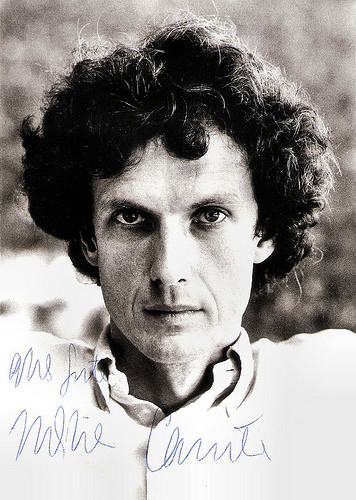
German postcard by Virginia Schmidt, Hamburg, ca. 1982. Photo: Virginia.
The final film of Romy Schneider
In 1980, Mathieu Carrière starred in Egon Schiele – Exzess und Bestrafung/Egon Schiele – Excess and Punishment (Herbert Vessely, 1981), based on the life of the Austrian Expressionist painter.
He then played a supporting part in the French film La femme de l'aviateur/The Aviator's Wife (1981), written and directed by Éric Rohmer. Like many of Rohmer’s films, it deals with the ever-evolving love lives of a group of young Parisians. This was the first in Rohmer's Comedies & Proverbs series.
He then appeared in the final film of Romy Schneider, La passante du Sans-Souci/The Passerby (Jacques Rouffio, 1982), based on a novel by Joseph Kessel. He followed it with the Belgian-French-Italian romantic drama Benvenuta (André Delvaux, 1983), with Fanny Ardant and Vittorio Gassman.
He returned to Germany to play in Die flambierte Frau/A Woman in Flames (Robert van Ackeren, 1983), starring Gudrun Landgrebe. The film was a enormous moneymaker in Germany. Again with Landgrebe and with his sister Mareike, he appeared in the Hungarian drama Yerma (Imre Gyöngyössy, Barna Kabay, 1984), based on the play by Federico García Lorca.
His later films include the Marguerite Yourcenar adaptation L'Œuvre au noir/The Abyss (André Delvaux, 1988), with Gian Maria Volonté and Samy Frey , and the West-German drama Zugzwang/Fool's Mate (1989), which he also wrote and directed.
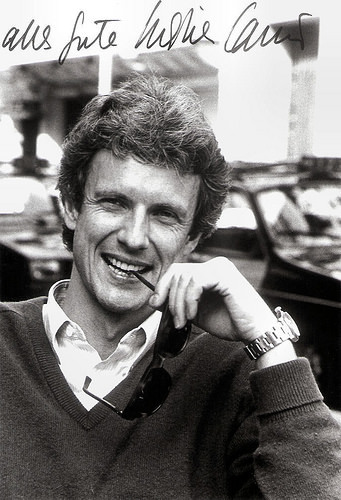
German autograph card.
Symbolically crucified in front of the German Ministery of Justice
During the following decades Mathieu Carrière started to work more and more for television, but there war still several film roles. In 1991, he appeared opposite Isabelle Huppert in the German-Austrian drama Malina (Werner Schroeter, 1991). The screenplay was adapted by Elfriede Jelinek from Ingeborg Bachmann's novel Malina.
It was followed by a part opposite Bruno Ganz in the German drama Erfolg/Success (Franz Seitz Jr., 1991) based on the famous novel by Lion Feuchtwanger.
His first American production was the historical adventure film Christopher Columbus: The Discovery (John Glen, 1992) with Marlon Brando , followed by the American World War II drama Shining Through (David Seltzer, 1992), starring Michael Douglas and Melanie Griffith.
He returned to Germany to co-star with Nina Hoss in Das Mädchen Rosemarie/A Girl Called Rose Marie (Bernd Eichinger, 1997), a remake of the highly-regarded film Das Maedchen Rosemarie/Rosemary (1958). This fact-based drama follows the rise and fall of a German beauty who went from ex-convict to courtesan of some of Germany's most powerful men to the victim of an unsolved murder.
Later films include the biopic Luther (Eric Till & Marc Canosa, 2003) starring Joseph Fiennes, the French crime-adventure film Arsène Lupin (Jean-Paul Salomé, 2004), based on the iconic series of novels about gentleman thief Arsène Lupin created by Maurice Leblanc, and the French thriller La marque des anges – Miserere/The Mark of the Angels – Miserere (Sylvain White, 2013), starring Gérard Depardieu . Despite a large budget, the latter film was poorly received by critics and failed to make an impact at the box office.
Mathieu Carrière has two daughters, Alice Isabelle (1985) with Jennifer Bartlett; and Elena Carriere (1996) with Bettina Catharina Proske. After losing a legal battle over custody for his daughter, he became a strong activist for the rights of fathers. In a controversial performance, he was symbolically crucified in front of the German Ministry of Justice in 2006.
German trailer Trailer Der junge Törless/Young Törless (Volker Schlöndorff, 1966). Source: Olga Kuzemko (YouTube).
Trailer for Arsène Lupin (Jean-Paul Salomé, 2004). Source: ClaraGmiki (YouTube).
Sources: AllMovie, Wikipedia (English and German), and.

Romanian postcard by Casa Filmului Acin.

German autograph card by TV Spielfilm.
Der junge Törless
Mathieu Carrière was born in 1950 in Hanover, Germany. His parents were Bern Carrière, a neurologist and psychiatrist, and Jutta Carrière. His brother Till Carrière and sister Mareike Carrière would both become actors too.
Carrière grew up in Berlin and Lübeck. The young Mathieu had his first stage role as Emil in a school stage production of Erich Kästner's Emil und die Detektive (Emil and the detectives) at the Gymnasium Katharineum in Lübeck.
At the age of 13, he played the young Tonio in the film adaptation of Thomas Mann's Tonio Kröger (Rolf Thiele, 1964), with Jean-Claude Brialy as the adult Tonio.
Mathieu attended the Jesuit boarding school Lycée Saint-François-Xavier in Vannes, France. This school had previously been attended by the director of Carrière's next film, Volker Schlöndorff. Carrière played Torless, a student in an expensive boarding school during the glory days of the Hapsburg empire in Der junge Törless/Young Törless (Volker Schlöndorff, 1966).
The film was adapted from the autobiographical novel Die Verwirrungen des Zoglings Torless (The Confusions of Young Törless) by Robert Musil. It deals with the violent, sadistic and homoerotic tendencies at an Austrian military academy at the beginning of the 20th century. The film won the FIPRESCI Prize at the 1966 Cannes Film Festival.
His next film was Vrata Raja/Gates to Paradise (1968) by Polish director Andrzej Wajda. Lionel Stander stars as a monk who leads a group of children from France to Jerusalem to protest the carnage of the Crusades between Christians and Muslims for ownership of the holy land. The film is based on a novel by Polish writer Jerzy Andrzejewski that seeks to expose the motives behind youthful religious zeal.
In 1969, Carrière moved to Paris to study philosophy and continue his acting.

Dutch collectors card in the series 'Filmsterren: een portret' by Edito Service, 1995. Photo: Collection La Cinémathèque Française. Publicity still for Der junge Törless/Young Törless (Volker Schlöndorf, 1966).
An arthouse hit
Mathieu Carrière played the leading role in the French-Italian-West German science fiction-drama L'Homme au cerveau greffé/Man with the Transplanted Brain (Jacques Doniol-Valcroze, 1971), the Belgian fantasy-horror Malpertuis/The Legend of Doom House (Harry Kümel, 1971) with Orson Welles , and the French-Belgian drama Rendez-vous à Bray/Rendezvous at Bray (André Delvaux, 1971), starring Anna Karina .
After this impressive start in France, his career seemed to go nowhere when he appeared in one of the final Brigitte Bardot films, the flop Don Juan ou Si Don Juan était une femme.../Don Juan, or If Don Juan Were a Woman (Roger Vadim, 1973), and in another Vadim debacle, La jeune fille assassinée/Charlotte or The Murdered Young Girl (Roger Vadim, 1974) with Sirpa Lane as a nymphomaniac.
In between, he had a supporting part in the interesting Italian film Giordano Bruno (Giuliano Montaldo, 1973), about the last years of the philosopher Giordano Bruno (Gian Maria Volonté) from 1592 to his execution in 1600.
An arthouse hit was the French drama India Song (Marguerite Duras, 1975), with Delphine Seyrig. India Song was nominated for three César Awards in 1976. Other known films with Carrière were the French crime-thriller Police Python 357/The Case Against Ferro (Alain Corneau, 1976) starring Yves Montand and Simone Signoret , and the West German film Der Fangschuß/Coup de Grâce (Volker Schlöndorff, 1976) adapted from the novel by Marguerite Yourcenar.
He also appeared in the French romantic drama Bilitis (1977) directed by photographer David Hamilton and shot in the his well-known soft focus style. Other films were the Swiss drama Les Indiens sont encore loin/The Indians Are Still Far Away (Patricia Moraz, 1977) with Isabelle Huppert , and the Belgian-French drama Een vrouw tussen hond en wolf/Woman Between Wolf and Dog (André Delvaux, 1979) with Marie-Christine Barrault and Rutger Hauer .

German postcard by Virginia Schmidt, Hamburg, ca. 1982. Photo: Virginia.
The final film of Romy Schneider
In 1980, Mathieu Carrière starred in Egon Schiele – Exzess und Bestrafung/Egon Schiele – Excess and Punishment (Herbert Vessely, 1981), based on the life of the Austrian Expressionist painter.
He then played a supporting part in the French film La femme de l'aviateur/The Aviator's Wife (1981), written and directed by Éric Rohmer. Like many of Rohmer’s films, it deals with the ever-evolving love lives of a group of young Parisians. This was the first in Rohmer's Comedies & Proverbs series.
He then appeared in the final film of Romy Schneider, La passante du Sans-Souci/The Passerby (Jacques Rouffio, 1982), based on a novel by Joseph Kessel. He followed it with the Belgian-French-Italian romantic drama Benvenuta (André Delvaux, 1983), with Fanny Ardant and Vittorio Gassman.
He returned to Germany to play in Die flambierte Frau/A Woman in Flames (Robert van Ackeren, 1983), starring Gudrun Landgrebe. The film was a enormous moneymaker in Germany. Again with Landgrebe and with his sister Mareike, he appeared in the Hungarian drama Yerma (Imre Gyöngyössy, Barna Kabay, 1984), based on the play by Federico García Lorca.
His later films include the Marguerite Yourcenar adaptation L'Œuvre au noir/The Abyss (André Delvaux, 1988), with Gian Maria Volonté and Samy Frey , and the West-German drama Zugzwang/Fool's Mate (1989), which he also wrote and directed.

German autograph card.
Symbolically crucified in front of the German Ministery of Justice
During the following decades Mathieu Carrière started to work more and more for television, but there war still several film roles. In 1991, he appeared opposite Isabelle Huppert in the German-Austrian drama Malina (Werner Schroeter, 1991). The screenplay was adapted by Elfriede Jelinek from Ingeborg Bachmann's novel Malina.
It was followed by a part opposite Bruno Ganz in the German drama Erfolg/Success (Franz Seitz Jr., 1991) based on the famous novel by Lion Feuchtwanger.
His first American production was the historical adventure film Christopher Columbus: The Discovery (John Glen, 1992) with Marlon Brando , followed by the American World War II drama Shining Through (David Seltzer, 1992), starring Michael Douglas and Melanie Griffith.
He returned to Germany to co-star with Nina Hoss in Das Mädchen Rosemarie/A Girl Called Rose Marie (Bernd Eichinger, 1997), a remake of the highly-regarded film Das Maedchen Rosemarie/Rosemary (1958). This fact-based drama follows the rise and fall of a German beauty who went from ex-convict to courtesan of some of Germany's most powerful men to the victim of an unsolved murder.
Later films include the biopic Luther (Eric Till & Marc Canosa, 2003) starring Joseph Fiennes, the French crime-adventure film Arsène Lupin (Jean-Paul Salomé, 2004), based on the iconic series of novels about gentleman thief Arsène Lupin created by Maurice Leblanc, and the French thriller La marque des anges – Miserere/The Mark of the Angels – Miserere (Sylvain White, 2013), starring Gérard Depardieu . Despite a large budget, the latter film was poorly received by critics and failed to make an impact at the box office.
Mathieu Carrière has two daughters, Alice Isabelle (1985) with Jennifer Bartlett; and Elena Carriere (1996) with Bettina Catharina Proske. After losing a legal battle over custody for his daughter, he became a strong activist for the rights of fathers. In a controversial performance, he was symbolically crucified in front of the German Ministry of Justice in 2006.
German trailer Trailer Der junge Törless/Young Törless (Volker Schlöndorff, 1966). Source: Olga Kuzemko (YouTube).
Trailer for Arsène Lupin (Jean-Paul Salomé, 2004). Source: ClaraGmiki (YouTube).
Sources: AllMovie, Wikipedia (English and German), and.
Published on August 02, 2017 22:00
August 1, 2017
Jean-Claude Bouillon (1941-2017)
Monday 31 July 2017 was a black day for the French cinema. Not only Jeanne Moreau but also French actor Jean Claude Bouillon passed away. He appeared in more than eighty films from 1966 until 2015. In France, Bouillon (1941-2017) was best known is best known for his role as Commissioner Valentin in the TV series Les Brigades du Tigre/The Tiger Brigade (1974-1983), but he also appeared in several films and on stage. He was 75.
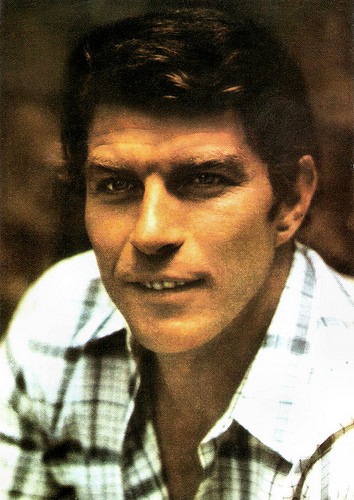
Romanian postcard by Casa Filmului Acin postcard.
Made in USA
Jean Claude André Bouillon was born in 1941 in Épinay-sur-Seine, France. He made his acting debut at the Théâtre national populaire (TNP) in 1966 in Armand Gatti's Chant public devant deux chaises électriques (Public chant in front of two electric chairs) on the Sacco and Vanzetti affair.
His first film appearance was as an inspector in Jean-Luc Godard's Made in USA (1966) with Anna Karina . He then played leading roles in several films: Le Dernier Homme/The Last Man (Charles Bitsch, 1968), Tout peut arrive/Don't Be Blue (1969) - the first film by Philippe Labro, Le Champignon/The Killer Strikes at Dawn (Marc Simenon, 1969) as the husband of Mylène Demongeot , and Hellé (Roger Vadim, 1972).
Perhaps his most interesting film of this period was the crime drama Un aller simple/One Way Ticket (José Giovanni, 1971). A failure was the erotic film Es war nicht die Nachtigall/Julia: Innocence Once Removed (Sigi Rothemund, 1974) in which he co-starred with Sylvia Kristel .
Later he played supporting parts in films like the thriller La raison d'état/State Reasons (André Cayatte, 1978) with Jean Yanne and Monica Vitti, the French-Italian drama L'Enfant de nuit/Child of the Night (Sergio Gobbi, 1978) with Agostina Belli, and the war film La légion saute sur Kolwezi/Operation Leopard (Raoul Coutard, 1978), filmed in French Guiana.
Bouillon has devoted most of his career to television in more than 40 television productions, TV movies and series. Very popular was his role as Commissioner Valentin, a seducer with a fine moustache, in the TV series Les Brigades du Tigre/The Tiger Brigades (1974-1983). The series was situated before the First World War when in France the first motorised police group was organised. They were called 'The Tiger Brigades', after Prime Minister George Clemenceau's surname: The Tiger.
His other TV roles included the photographer Christophe Bardol in the mini-series Les Roses de Dublin/The Roses of Dublin (1981), and Dimitri in the series Les Aventures du jeune Patrick Pacard/The Adventures of the young Patrick Pacard (1984).
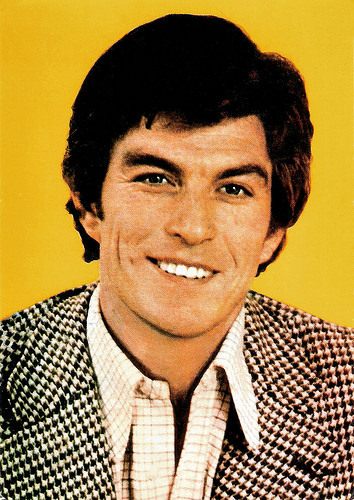
Romanian postcard by Casa Filmului Acin postcard, no. 589.
The Unbearable Lightness of Being
Jean-Claude Bouillon’s best known film is The Unbearable Lightness of Being (Philip Kaufman, 1988), based on the novel by Milan Kundera. The film starred Daniel Day Lewis and Juliette Binoche , and Bouillon only played a minor part.
On stage he played major roles in more than 27 productions, including Gone with the Wind (1983), La Double Inconstance (1988) by Marivaux, Huis clos (1991) by Jean-Paul Sartre, Les Mufles by Sacha Guitry , South (1994) by Julien Green, The Seagull (1998) by Anton Chekov, and L'Intrus (2011) by Antoine Rault.
He played several supporting parts in popular films, such as in the romantic comedy Arlette (Claude Zidi, 1997) featuring Josiane Balasko, the comedy Un grand cri d'amour/A great cry of love (Josiane Balasko, 1998) starring Balasko and Richard Berry , and the thriller Le Serpent/The Serpent (Éric Barbier, 2006) with Yvan Attal.
One of his best known roles remained Serge Létan, the lover of Claude Jade , in the TV soap opera Cap des Pins (1998-2000). Another success was the series Sous le soleil/Under the Sun (2003-2007). Bouillon also appeared in foreign TV productions such as The Hitchhiker, where he played Victor, the aggressive husband of Claude Jade , in the episode Windows (1990).
In the cinema he was last seen in the comedy Coups de soleil (Stéphane Kowalczyk, 2011) and the short film Irrésistible/Irresistible (Gioacchino Campanella, 2013).
Jean-Claude Bouillon died on 31 July 2017 of cancer in Marseilles, where he had lived for several years with his wife, Ghislaine Valence, whom he had married in 1987. He had two children: Alexandre (born in 1970) and Bérénice (1981).
Jean Claude Bouillon's character has a bad trip in an unknown French film of the 1970s. Source: Jhalal Drut (YouTube).
Sources: Le Figaro (French), Wikipedia (French and English) and .

Romanian postcard by Casa Filmului Acin postcard.
Made in USA
Jean Claude André Bouillon was born in 1941 in Épinay-sur-Seine, France. He made his acting debut at the Théâtre national populaire (TNP) in 1966 in Armand Gatti's Chant public devant deux chaises électriques (Public chant in front of two electric chairs) on the Sacco and Vanzetti affair.
His first film appearance was as an inspector in Jean-Luc Godard's Made in USA (1966) with Anna Karina . He then played leading roles in several films: Le Dernier Homme/The Last Man (Charles Bitsch, 1968), Tout peut arrive/Don't Be Blue (1969) - the first film by Philippe Labro, Le Champignon/The Killer Strikes at Dawn (Marc Simenon, 1969) as the husband of Mylène Demongeot , and Hellé (Roger Vadim, 1972).
Perhaps his most interesting film of this period was the crime drama Un aller simple/One Way Ticket (José Giovanni, 1971). A failure was the erotic film Es war nicht die Nachtigall/Julia: Innocence Once Removed (Sigi Rothemund, 1974) in which he co-starred with Sylvia Kristel .
Later he played supporting parts in films like the thriller La raison d'état/State Reasons (André Cayatte, 1978) with Jean Yanne and Monica Vitti, the French-Italian drama L'Enfant de nuit/Child of the Night (Sergio Gobbi, 1978) with Agostina Belli, and the war film La légion saute sur Kolwezi/Operation Leopard (Raoul Coutard, 1978), filmed in French Guiana.
Bouillon has devoted most of his career to television in more than 40 television productions, TV movies and series. Very popular was his role as Commissioner Valentin, a seducer with a fine moustache, in the TV series Les Brigades du Tigre/The Tiger Brigades (1974-1983). The series was situated before the First World War when in France the first motorised police group was organised. They were called 'The Tiger Brigades', after Prime Minister George Clemenceau's surname: The Tiger.
His other TV roles included the photographer Christophe Bardol in the mini-series Les Roses de Dublin/The Roses of Dublin (1981), and Dimitri in the series Les Aventures du jeune Patrick Pacard/The Adventures of the young Patrick Pacard (1984).

Romanian postcard by Casa Filmului Acin postcard, no. 589.
The Unbearable Lightness of Being
Jean-Claude Bouillon’s best known film is The Unbearable Lightness of Being (Philip Kaufman, 1988), based on the novel by Milan Kundera. The film starred Daniel Day Lewis and Juliette Binoche , and Bouillon only played a minor part.
On stage he played major roles in more than 27 productions, including Gone with the Wind (1983), La Double Inconstance (1988) by Marivaux, Huis clos (1991) by Jean-Paul Sartre, Les Mufles by Sacha Guitry , South (1994) by Julien Green, The Seagull (1998) by Anton Chekov, and L'Intrus (2011) by Antoine Rault.
He played several supporting parts in popular films, such as in the romantic comedy Arlette (Claude Zidi, 1997) featuring Josiane Balasko, the comedy Un grand cri d'amour/A great cry of love (Josiane Balasko, 1998) starring Balasko and Richard Berry , and the thriller Le Serpent/The Serpent (Éric Barbier, 2006) with Yvan Attal.
One of his best known roles remained Serge Létan, the lover of Claude Jade , in the TV soap opera Cap des Pins (1998-2000). Another success was the series Sous le soleil/Under the Sun (2003-2007). Bouillon also appeared in foreign TV productions such as The Hitchhiker, where he played Victor, the aggressive husband of Claude Jade , in the episode Windows (1990).
In the cinema he was last seen in the comedy Coups de soleil (Stéphane Kowalczyk, 2011) and the short film Irrésistible/Irresistible (Gioacchino Campanella, 2013).
Jean-Claude Bouillon died on 31 July 2017 of cancer in Marseilles, where he had lived for several years with his wife, Ghislaine Valence, whom he had married in 1987. He had two children: Alexandre (born in 1970) and Bérénice (1981).
Jean Claude Bouillon's character has a bad trip in an unknown French film of the 1970s. Source: Jhalal Drut (YouTube).
Sources: Le Figaro (French), Wikipedia (French and English) and .
Published on August 01, 2017 22:00
July 31, 2017
Jeanne Moreau (1928-2017)
French actress Jeanne Moreau, one of biggest stars of the European cinema, has died today at the age of 89. Moreau was found dead at her home in Paris. The legendary film star was the personification of French womanhood and sensuality. Moreau (1928-2017) had a diverse career: she was a magnificent stage and film actress, a producer, screenwriter and film director, a successful singer with a substantial recording career, and a theatre and opera director. She combined off-kilter beauty with strong character in Nouvelle Vague classics as Ascenseur pour l'échafaud (1958) and Les amants (1959). Her role as the flamboyant, free-spirited Catherine with her devil-may-care sensuality in Jules et Jim (1962) is one of the greatest performances in the history of the cinema. Throughout her long career with more than 130 films, Jeanne Moreau worked with some of the most notable film directors ever.

French postcard by E.D.U.G., no. 81. Photo: Sam Lévin.
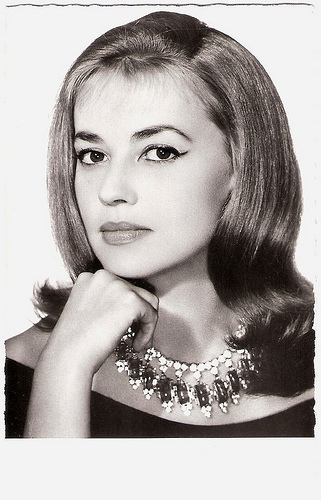
French postcard by Editions P.I., no. 987. Photo: Sam Lévin.
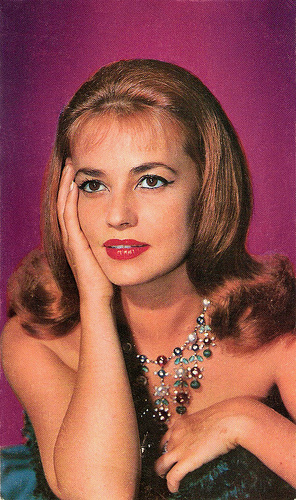
French postcard by E.D.U.G., no. 275. Offered by Corvisart, Epinal. Photo: Sam Lévin.
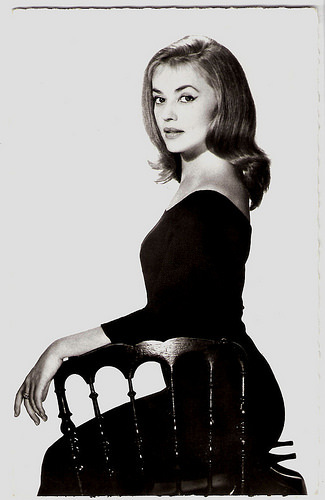
French postcard by Editions du Globe, Paris no. 809. Photo: Sam Lévin, Paris.
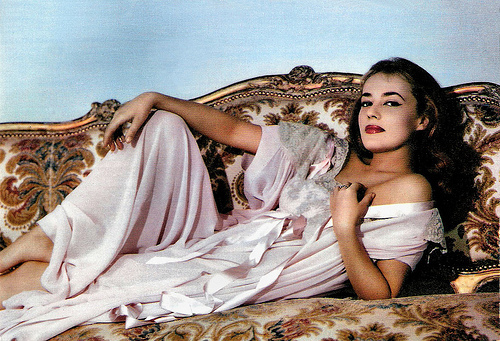
French postcard by Editions P.I., Paris, no. 1017. Photo: Sam Lévin.
Alien Enemies
Jeanne Moreau was born in 1928, Paris, France. Her father, Anatole-Désiré Moreau, owned a restaurant in Montmartre, Paris. Her mother, Katherine Buckley, was an English dancer who had come to the Folies Bergère with the Tiller Girls.
Jeanne grew up living part of the time in Paris, and part of the time in Mazirat, her father's native village. During the Second World War, Katherine and Jeanne were forced to stay in Paris; classified as alien enemies. She attended the Lycee Edgar Quinet in Paris, and began to discover her love of literature and the theatre.
When her parents divorced in the late 1940s and her mother returned to England, Jeanne remained with her father in Montmartre. Opposing her father's wishes, she decided to become an actress. She trained for the stage at the Paris Conservatoire, and made her theatrical debut in 1947 at the Avignon Festival.
In 1948, when she was only 20 years old, she became the youngest full-time member in the history of the Comédie-Française, France's most prestigious theatrical company. Her first play was Ivan Turgenev's A Month in the Country, directed by Jean Meyer. She soon was one of the leading actresses of the troupe and was recognised as the prime stage actress of her generation.
She left in 1951, finding the Comédie-Française too restrictive and authoritarian, and joined the more experimental Théâtre Nationale Populaire.
Moreau also began playing small roles in films like Dernier amour/Last Love (Jean Stelli, 1949). During the 1950s, she appeared in several mainstream films like the superb thriller Touchez pas au grisbi/Grisbi (Jacques Becker, 1953) with Jean Gabin and the colourful historical drama La reine Margot/Queen Margot (Jean Dréville, 1954).
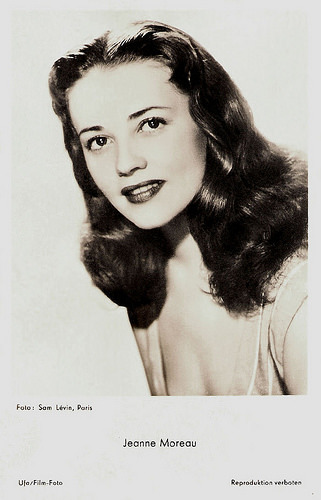 German postcard by Ufa, Berlin-Tempelhof, no. FK 1015. Photo: Sam Lévin, Paris.
German postcard by Ufa, Berlin-Tempelhof, no. FK 1015. Photo: Sam Lévin, Paris.
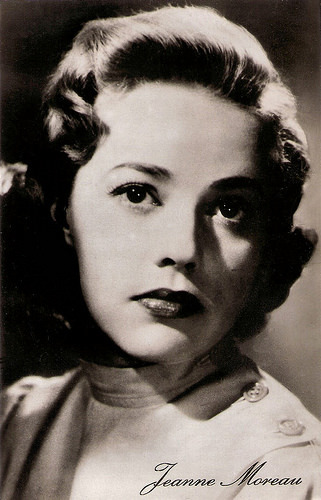
East-German postcard by VEB Progress Film-Vertrieb, Berlin, 514, 1957. Photo: Unifrance. Publicity still for Les hommes en blanc/Men in White (Ralph Habib, 1955).
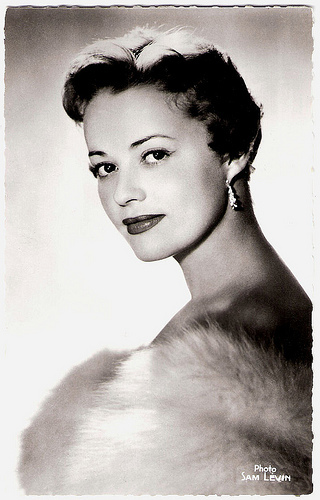
French postcard by Editions du Globe (E.D.U.G.), no. 328. Photo: Sam Lévin.
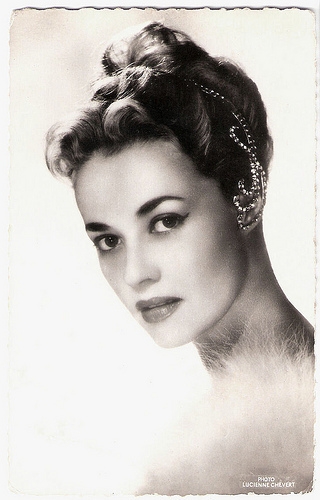
French postcard by Editions du Globe (E.D.U.G.), no. 620. Photo: Lucienne Chevert.
Scandal
Jeanne Moreau was almost 30 before her film career really took off thanks to her work with first-time director Louis Malle. His murder mystery Ascenseur pour l'échafaud seemed to be in the same thriller genre as her earlier films, but after seeing the first week of dailies for Ascenseur the technicians at the film lab went to the producer and said: “You must not let Malle destroy Jeanne Moreau”.
Louis Malle later explained: “She was lit only by the windows of the Champs Elysées. That had never been done. Cameramen would have forced her to wear a lot of make-up and they would put a lot of light on her, because, supposedly, her face was not photogenic”.
This lack of artifice revealed Moreau's ‘essential qualities’: "she could be almost ugly and then, ten seconds later, she would turn her face and would be incredibly attractive. But she would be herself.”
Ascenseur pour l'échafaud/Elevator to the Gallows (Louis Malle, 1958) was immediately followed by the controversial Les amants/The Lovers (Louis Malle, 1958). Moreau starred as a provincial wife who abandons her family for a man she has just met. Her earthy, intelligent and subtle portrayal of the adulteress caused a scandal in France.
The erotic scenes caused censorship problems all over the world. The American gossip columnists tagged her as 'The New Bardot' and Moreau instantly became an international sex symbol. Malle and his star separated privately, but professionally they would make several more films together, including the excellent Le feu follet/The Fire Within (1963).
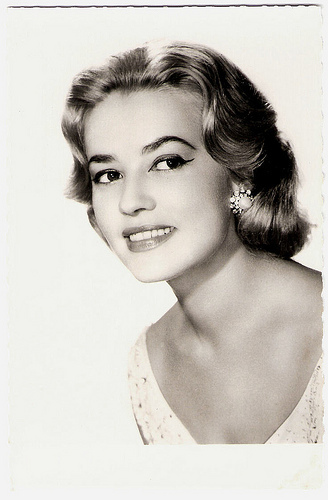
French postcard by Editions P.I., no. 931. Offered by Les Carbones Korès 'Carboplane'. Photo: Sam Lévin.
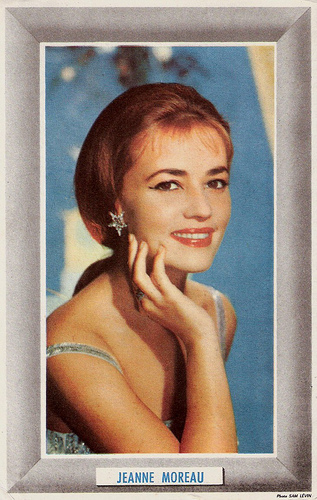
French postcard by St. Anne, Marseille. Photo: Sam Lévin.
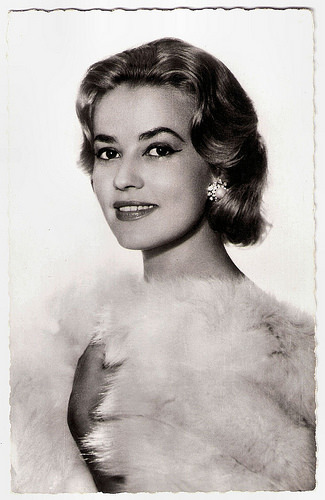
French postcard by Editions du Globe, Paris no. 734. Photo: Sam Lévin, Paris.
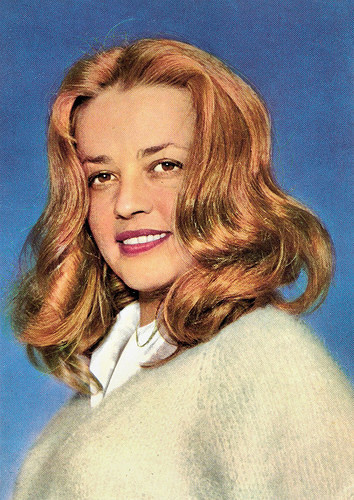
Italian postcard by Rotalcolor, Milano, no. 258.
Marguerite Duras
Jeanne Moreau went on to work with many of the best known Nouvelle Vague (New Wave) and avant-garde directors. Her most enduring role is the flamboyant and magnetic Catherine in Truffaut's explosive Jules et Jim/Jules and Jim (François Truffaut), 1962.
She co-produced Jules et Jim herself and also co-produced La baie des anges/Bay of Angels (Jacques Demy, 1963) and Peau de banane/Banana Peel (Marcel Ophüls, 1963).
Her teaming with Brigitte Bardot in Viva Maria! (Louis Malle, 1965) was one of the major media events of 1965. Thanks to the on-screen chemistry between the two top French female stars of the period, the film became an international hit. Five years after Jules et Jim, she worked again with François Truffaut, starring as an icy murderess in the popular Alfred Hitchcock homage La mariée était en noir/The Bride Wore Black (1967).
She also worked with such notable directors as Michelangelo Antonioni at La notte/The Night (1961), and Beyond the Clouds (1995), Orson Welles (Le procès/The Trial, 1962; Campanadas a medianoche/Chimes at Midnight, 1965; L’histoire immortelle/The Immortal Story, 1968; and the unfinished The Deep, 1970), Joseph Losey (Eva, 1962; Mr. Klein, 1976), Luis Buñuel (Le journal d'une femme de chambre/Diary of a Chambermaid, 1964), Elia Kazan (The Last Tycoon, 1976), Rainer Werner Fassbinder (Querelle, 1982), and Wim Wenders (Bis ans Ende der Welt/Until the End of the World, 1991).
Her stage hits include Anna Bonacci's L'heure éblouissante/The Dazzling Hour (1953), Jean Cocteau's La machine infernale (1954, as the Sphinx), George Bernard Shaw's Pygmalion (1955, as Eliza Doolittle), Tennessee Williams' Cat on a Hot Tin Roof (1956, as Maggie), Frank Wedekind's Lulu/Loulou (1976, title role), and Tennessee Williams' The Night of the Iguana (1985, as Hannah Jelkes).
She won the Best Actress Molière Award (the French equivalent of the Tony) in 1988 for her acclaimed performance in Hermann Broch's Le récit de la servante Zerline, a huge theatrical success which toured 11 countries. Moreau also enjoyed success as a vocalist. She released several albums and once performed with Frank Sinatra at Carnegie Hall.
Her name has been often associated, both socially and professionally, to that of writer-director Marguerite Duras. Apart from their close friendship, Moreau starred in two films based on Duras' novels, Moderato cantabile/Seven Days ... Seven Nights (Peter Brooks, 1960) and The Sailor from Gibraltar (Tony Richardson, 1970). Duras herself directed Moreau in Nathalie Granger (1972), and she was the narrator in another Duras screen adaptation, L'amant/The Lover (Jean-Jacques Annaud, 1992). She even went on to portray Duras in the biopic Cet amour-là/This Love (Josée Dayan, 2001).
Other major literary figures among her close friends were Jean Cocteau, Jean Genet, Henry Miller, and Anaïs Nin. Jeanne Moreau was the president of Equinoxe, an organisation which supports new European scriptwriters.

Small Romanian collectors card. Photo: publicity stil for La Notte (Michelangerlo Antonioni, 1961) with Jeanne Moreau and Marcello Mastroianni.

Romanian postcard by Casa Filmului Acin, no. 471. Photo: publicity still of Jeanne Moreau and Anthony Perkins in Le procès/The Trial (Orson Welles, 1962).
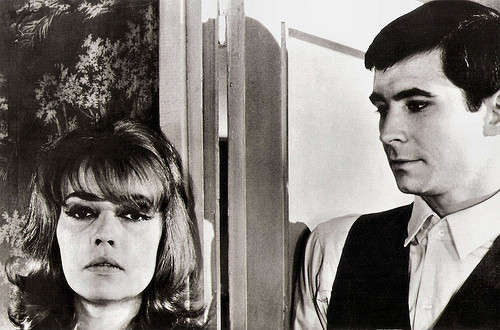
Romanian postcard by Casa Filmului Acin, no. 491. Photo: publicity still of Jeanne Moreau and Anthony Perkins in Le procès/The Trial (Orson Welles, 1962).
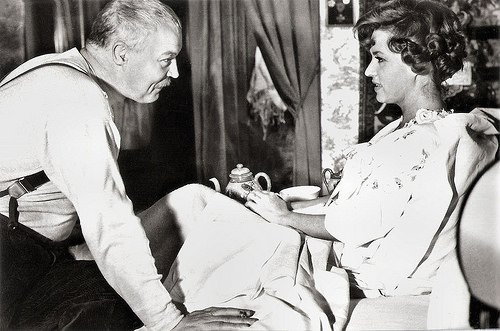
Romanian postcard by Casa Filmului Acin, no. 445. Photo: publicity still of Daniel Ivernel and Jeanne Moreau in Le journal d'une femme de chambre/The Diary of a Chambermaid (Luis Buñuel, 1964).
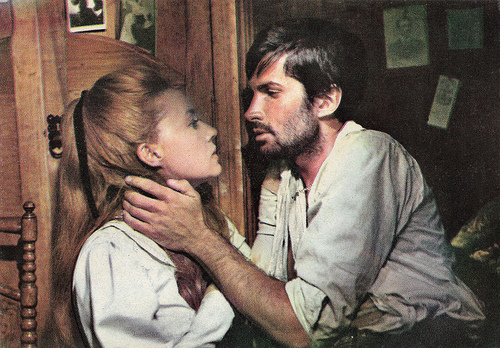
Italian postcard. Photo: Dear Film. Publicity still of Jeanne Moreau and George Hamilton in Via Maria! (Louis Malle, 1965).
Honours
As her leading-lady days began to wane, Jeanne Moreau made a graceful transition to character parts. She used her standing in the French industry to foster the careers of young directors such as Bertrand Blier, in whose 1974 feature Les valseuses/Going Places, she gave a cryptic but memorable performance, and Andre Techiné.
In 1975 she made her debut as a director with Lumière/Light (1975), the story of several generations of actresses. She also wrote the script and played Sarah, an actress the same age as Moreau. She also helmed L'Adolescente/The Adolescent (1978), a semi-autobiographical tale of a girl sent to live with her grandmother in 1939, and Lillian Gish (1984), an homage to the silent screen heroine.
She was the only actress who has presided twice over the jury of the Cannes Film Festival (in 1975 and 1995) and she was president of the jury at the Berlin Film Festival in 1983. She has won a number of honours, including two BAFTA Awards, three Cesars (the French Oscar), a Golden Lion for career achievement at the 1991 Venice Film Festival and a 1997 European Film Academy Lifetime Achievement Award.
In 1998 the American Academy of Motion Pictures presented her a life tribute. She also was made a Fellow of the British Film Institute in recognition of her outstanding contribution to film culture. And she was chosen by Empire magazine as one of the 100 Sexiest Stars in film history (#76) in 1995.
In 2000 she made her debut as a stage director with a Geneva and Paris production of Margaret Edson's Wit. The following year she was the first woman to enter the Academie des Beaux-Arts of Paris. In 2001 she also made her debut as an opera director with an Opera National de Paris production of Giuseppe Verdi's Attila.
Among her last films are Le temps qui reste/Time to Leave (François Ozon, 2005), Disengagement (Amos Gitai, 2007) and Visage/Face (Ming-liang Tsai, 2009).
Jeanne Moreau wasn romantically involved with Louis Malle, Francois Truffaut, Lee Marvin, and fashion designer Pierre Cardin. Vanessa Redgrave named Moreau as co-respondent in her 1967 divorce from director Tony Richardson on grounds of adultery. Richardson and Moreau would never marry.
Jeanne Moreau married - and divorced - three times: to actor-director Jean-Louis Richard (1949-1951), to Greek actor Teodoro Rubanis (1966-1967), and to Excorcist director William Friedkin (1977-1980). She had a son with Richard, Jérôme Richard (1950) who is a successful painter.
Trailer for Ascenseur pour l'échafaud/Lift to the Scaffold (1958). Music: Miles Davis. Source: BFI Trailers (YouTube).
Trailer for Les amants (1958). Source: Corey Mike (YouTube).
Trailer La notte (1961). Source: Rialto Films (YouTube).
Jeanne Moreau sings Le Tourbillon in Jules et Jim (1962). Source: Dansmoncafé (YouTube).
Jeanne Moreau sings Each man kills the thing he loves in Querelle (1982). Source: KLAUSHY Br (YouTube).
Sources: Rebecca Flint Marx (AllMovie), (IMDb), Filmreference.com, Wikipedia, and .

French postcard by E.D.U.G., no. 81. Photo: Sam Lévin.

French postcard by Editions P.I., no. 987. Photo: Sam Lévin.

French postcard by E.D.U.G., no. 275. Offered by Corvisart, Epinal. Photo: Sam Lévin.

French postcard by Editions du Globe, Paris no. 809. Photo: Sam Lévin, Paris.

French postcard by Editions P.I., Paris, no. 1017. Photo: Sam Lévin.
Alien Enemies
Jeanne Moreau was born in 1928, Paris, France. Her father, Anatole-Désiré Moreau, owned a restaurant in Montmartre, Paris. Her mother, Katherine Buckley, was an English dancer who had come to the Folies Bergère with the Tiller Girls.
Jeanne grew up living part of the time in Paris, and part of the time in Mazirat, her father's native village. During the Second World War, Katherine and Jeanne were forced to stay in Paris; classified as alien enemies. She attended the Lycee Edgar Quinet in Paris, and began to discover her love of literature and the theatre.
When her parents divorced in the late 1940s and her mother returned to England, Jeanne remained with her father in Montmartre. Opposing her father's wishes, she decided to become an actress. She trained for the stage at the Paris Conservatoire, and made her theatrical debut in 1947 at the Avignon Festival.
In 1948, when she was only 20 years old, she became the youngest full-time member in the history of the Comédie-Française, France's most prestigious theatrical company. Her first play was Ivan Turgenev's A Month in the Country, directed by Jean Meyer. She soon was one of the leading actresses of the troupe and was recognised as the prime stage actress of her generation.
She left in 1951, finding the Comédie-Française too restrictive and authoritarian, and joined the more experimental Théâtre Nationale Populaire.
Moreau also began playing small roles in films like Dernier amour/Last Love (Jean Stelli, 1949). During the 1950s, she appeared in several mainstream films like the superb thriller Touchez pas au grisbi/Grisbi (Jacques Becker, 1953) with Jean Gabin and the colourful historical drama La reine Margot/Queen Margot (Jean Dréville, 1954).
 German postcard by Ufa, Berlin-Tempelhof, no. FK 1015. Photo: Sam Lévin, Paris.
German postcard by Ufa, Berlin-Tempelhof, no. FK 1015. Photo: Sam Lévin, Paris.
East-German postcard by VEB Progress Film-Vertrieb, Berlin, 514, 1957. Photo: Unifrance. Publicity still for Les hommes en blanc/Men in White (Ralph Habib, 1955).

French postcard by Editions du Globe (E.D.U.G.), no. 328. Photo: Sam Lévin.

French postcard by Editions du Globe (E.D.U.G.), no. 620. Photo: Lucienne Chevert.
Scandal
Jeanne Moreau was almost 30 before her film career really took off thanks to her work with first-time director Louis Malle. His murder mystery Ascenseur pour l'échafaud seemed to be in the same thriller genre as her earlier films, but after seeing the first week of dailies for Ascenseur the technicians at the film lab went to the producer and said: “You must not let Malle destroy Jeanne Moreau”.
Louis Malle later explained: “She was lit only by the windows of the Champs Elysées. That had never been done. Cameramen would have forced her to wear a lot of make-up and they would put a lot of light on her, because, supposedly, her face was not photogenic”.
This lack of artifice revealed Moreau's ‘essential qualities’: "she could be almost ugly and then, ten seconds later, she would turn her face and would be incredibly attractive. But she would be herself.”
Ascenseur pour l'échafaud/Elevator to the Gallows (Louis Malle, 1958) was immediately followed by the controversial Les amants/The Lovers (Louis Malle, 1958). Moreau starred as a provincial wife who abandons her family for a man she has just met. Her earthy, intelligent and subtle portrayal of the adulteress caused a scandal in France.
The erotic scenes caused censorship problems all over the world. The American gossip columnists tagged her as 'The New Bardot' and Moreau instantly became an international sex symbol. Malle and his star separated privately, but professionally they would make several more films together, including the excellent Le feu follet/The Fire Within (1963).

French postcard by Editions P.I., no. 931. Offered by Les Carbones Korès 'Carboplane'. Photo: Sam Lévin.

French postcard by St. Anne, Marseille. Photo: Sam Lévin.

French postcard by Editions du Globe, Paris no. 734. Photo: Sam Lévin, Paris.

Italian postcard by Rotalcolor, Milano, no. 258.
Marguerite Duras
Jeanne Moreau went on to work with many of the best known Nouvelle Vague (New Wave) and avant-garde directors. Her most enduring role is the flamboyant and magnetic Catherine in Truffaut's explosive Jules et Jim/Jules and Jim (François Truffaut), 1962.
She co-produced Jules et Jim herself and also co-produced La baie des anges/Bay of Angels (Jacques Demy, 1963) and Peau de banane/Banana Peel (Marcel Ophüls, 1963).
Her teaming with Brigitte Bardot in Viva Maria! (Louis Malle, 1965) was one of the major media events of 1965. Thanks to the on-screen chemistry between the two top French female stars of the period, the film became an international hit. Five years after Jules et Jim, she worked again with François Truffaut, starring as an icy murderess in the popular Alfred Hitchcock homage La mariée était en noir/The Bride Wore Black (1967).
She also worked with such notable directors as Michelangelo Antonioni at La notte/The Night (1961), and Beyond the Clouds (1995), Orson Welles (Le procès/The Trial, 1962; Campanadas a medianoche/Chimes at Midnight, 1965; L’histoire immortelle/The Immortal Story, 1968; and the unfinished The Deep, 1970), Joseph Losey (Eva, 1962; Mr. Klein, 1976), Luis Buñuel (Le journal d'une femme de chambre/Diary of a Chambermaid, 1964), Elia Kazan (The Last Tycoon, 1976), Rainer Werner Fassbinder (Querelle, 1982), and Wim Wenders (Bis ans Ende der Welt/Until the End of the World, 1991).
Her stage hits include Anna Bonacci's L'heure éblouissante/The Dazzling Hour (1953), Jean Cocteau's La machine infernale (1954, as the Sphinx), George Bernard Shaw's Pygmalion (1955, as Eliza Doolittle), Tennessee Williams' Cat on a Hot Tin Roof (1956, as Maggie), Frank Wedekind's Lulu/Loulou (1976, title role), and Tennessee Williams' The Night of the Iguana (1985, as Hannah Jelkes).
She won the Best Actress Molière Award (the French equivalent of the Tony) in 1988 for her acclaimed performance in Hermann Broch's Le récit de la servante Zerline, a huge theatrical success which toured 11 countries. Moreau also enjoyed success as a vocalist. She released several albums and once performed with Frank Sinatra at Carnegie Hall.
Her name has been often associated, both socially and professionally, to that of writer-director Marguerite Duras. Apart from their close friendship, Moreau starred in two films based on Duras' novels, Moderato cantabile/Seven Days ... Seven Nights (Peter Brooks, 1960) and The Sailor from Gibraltar (Tony Richardson, 1970). Duras herself directed Moreau in Nathalie Granger (1972), and she was the narrator in another Duras screen adaptation, L'amant/The Lover (Jean-Jacques Annaud, 1992). She even went on to portray Duras in the biopic Cet amour-là/This Love (Josée Dayan, 2001).
Other major literary figures among her close friends were Jean Cocteau, Jean Genet, Henry Miller, and Anaïs Nin. Jeanne Moreau was the president of Equinoxe, an organisation which supports new European scriptwriters.

Small Romanian collectors card. Photo: publicity stil for La Notte (Michelangerlo Antonioni, 1961) with Jeanne Moreau and Marcello Mastroianni.

Romanian postcard by Casa Filmului Acin, no. 471. Photo: publicity still of Jeanne Moreau and Anthony Perkins in Le procès/The Trial (Orson Welles, 1962).

Romanian postcard by Casa Filmului Acin, no. 491. Photo: publicity still of Jeanne Moreau and Anthony Perkins in Le procès/The Trial (Orson Welles, 1962).

Romanian postcard by Casa Filmului Acin, no. 445. Photo: publicity still of Daniel Ivernel and Jeanne Moreau in Le journal d'une femme de chambre/The Diary of a Chambermaid (Luis Buñuel, 1964).

Italian postcard. Photo: Dear Film. Publicity still of Jeanne Moreau and George Hamilton in Via Maria! (Louis Malle, 1965).
Honours
As her leading-lady days began to wane, Jeanne Moreau made a graceful transition to character parts. She used her standing in the French industry to foster the careers of young directors such as Bertrand Blier, in whose 1974 feature Les valseuses/Going Places, she gave a cryptic but memorable performance, and Andre Techiné.
In 1975 she made her debut as a director with Lumière/Light (1975), the story of several generations of actresses. She also wrote the script and played Sarah, an actress the same age as Moreau. She also helmed L'Adolescente/The Adolescent (1978), a semi-autobiographical tale of a girl sent to live with her grandmother in 1939, and Lillian Gish (1984), an homage to the silent screen heroine.
She was the only actress who has presided twice over the jury of the Cannes Film Festival (in 1975 and 1995) and she was president of the jury at the Berlin Film Festival in 1983. She has won a number of honours, including two BAFTA Awards, three Cesars (the French Oscar), a Golden Lion for career achievement at the 1991 Venice Film Festival and a 1997 European Film Academy Lifetime Achievement Award.
In 1998 the American Academy of Motion Pictures presented her a life tribute. She also was made a Fellow of the British Film Institute in recognition of her outstanding contribution to film culture. And she was chosen by Empire magazine as one of the 100 Sexiest Stars in film history (#76) in 1995.
In 2000 she made her debut as a stage director with a Geneva and Paris production of Margaret Edson's Wit. The following year she was the first woman to enter the Academie des Beaux-Arts of Paris. In 2001 she also made her debut as an opera director with an Opera National de Paris production of Giuseppe Verdi's Attila.
Among her last films are Le temps qui reste/Time to Leave (François Ozon, 2005), Disengagement (Amos Gitai, 2007) and Visage/Face (Ming-liang Tsai, 2009).
Jeanne Moreau wasn romantically involved with Louis Malle, Francois Truffaut, Lee Marvin, and fashion designer Pierre Cardin. Vanessa Redgrave named Moreau as co-respondent in her 1967 divorce from director Tony Richardson on grounds of adultery. Richardson and Moreau would never marry.
Jeanne Moreau married - and divorced - three times: to actor-director Jean-Louis Richard (1949-1951), to Greek actor Teodoro Rubanis (1966-1967), and to Excorcist director William Friedkin (1977-1980). She had a son with Richard, Jérôme Richard (1950) who is a successful painter.
Trailer for Ascenseur pour l'échafaud/Lift to the Scaffold (1958). Music: Miles Davis. Source: BFI Trailers (YouTube).
Trailer for Les amants (1958). Source: Corey Mike (YouTube).
Trailer La notte (1961). Source: Rialto Films (YouTube).
Jeanne Moreau sings Le Tourbillon in Jules et Jim (1962). Source: Dansmoncafé (YouTube).
Jeanne Moreau sings Each man kills the thing he loves in Querelle (1982). Source: KLAUSHY Br (YouTube).
Sources: Rebecca Flint Marx (AllMovie), (IMDb), Filmreference.com, Wikipedia, and .
Published on July 31, 2017 10:00
July 30, 2017
Kai Fischer
Red-haired and spirited German actress Kai Fischer (1934) has appeared in 54 films between 1955 and 2004. She was the naughty bad girl of the Wirtschaftwunder cinema, and also appeared in sexy roles in international productions, either as a prostitute or a gangster girl. Later she worked with famous directors as Wim Wenders, Rosa von Praunheim and Ingmar Bergman.

German postcard by Ufa, Berlin-Tempelhhof, no. FK 4095. Photo: Ufa.
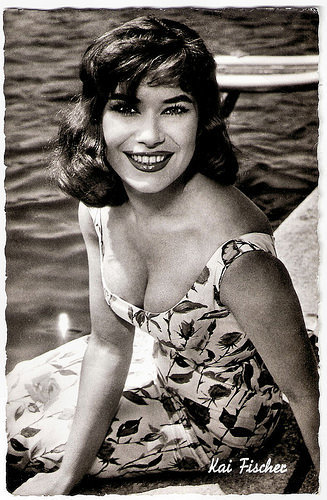
Austrian postcard by Kellner-Fotokarten, Wien, no. 287.
Either a gangster bride, a criminal bar girl or a prostitute
Kai Anne Inge Fischer was born in Halle, Germany (according to the German version of Wikipedia while the English version and IMDb mention Prague, Czechoslovakia, as her birthplace) in 1934. Fischer's family was forced to move to Munich in 1945.
In the 1950s the young Kai Fischer (also credited as Kay Fischer) appeared in the cabaret Schwabinger Brettl without a stage training and also worked as a photo model and mannequin.
In 1955, she entered the cinema. She initially played supporting roles in such films as the German-Austrian comedy Oh diese lieben Verwandten/Oh these dear relatives (Joe Stöckel, 1955) and Unternehmen Schlafsack/Operation Sleeping Bag (Arthur Maria Rabenalt, 1955).
She had her first major role in the drama Die Ehe des Dr. med. Danwitz/The Marriage of Doctor Danwitz (Arthur Maria Rabenalt, 1956), starring Marianne Koch and Karlheinz Böhm .
Very popular was the musical comedy Das Wirtshaus im Spessart/The Spessart Inn (Kurt Hoffmann, 1958), starring Liselotte Pulver and Carlos Thompson .
In Italy, Fischer appeared in La ragazza della salina/Sand, Love and Salt (Frantisek Cáp, 1957) with Marcello Mastroianni , and in the comedy Tempi duri per i vampiri/Hard Times for Dracula (Steno, 1959) with Renato Rascel and Christopher Lee .
Until the mid-1960s, Fischer often played sexy, bad girls in films. She was either a gangster bride, a criminal bar girl or a prostitute in such films as Für zwei Groschen Zärtlichkeit/Call Girls (Arthur Maria Rabenalt, 1957), the French drama Filles de nuit/Girls of the Night (Maurice Cloche, 1958) with Georges Marchal, Mädchen für die Mambo-Bar/$100 a Night (Wolfgang Glück, 1959) and the Edgar Wallace Krimi Zimmer 13/Room 13 (Harald Reinl, 1964), starring Joachim Fuchsberger .

Austrian postcard by Kellner-Fotokarten, Wien, no. 1394. Photo: Deutsche Cosmopol-film / Brünjes. Publicity still for Ich war ihm hörig/I Was All His (Wolfgang Becker, 1958).
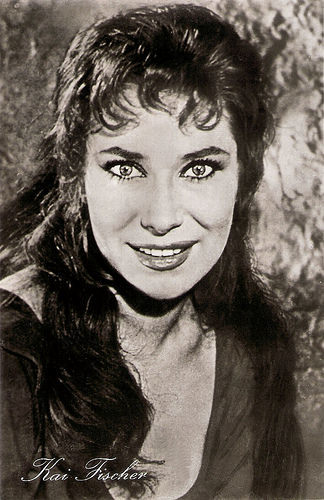
East-German postcard by VEB Progress Film-Vertrieb, Berlin, no. 1108, 1959. Photo: publicity still for Das Wirtshaus im Spessart/The Spessart Inn (Kurt Hoffmann, 1958).
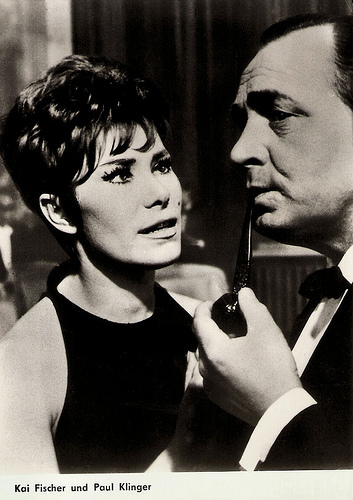
East-German postcard by VEB Progress Film-Vertrieb, Berlin, no. 3034, 1968. Photo: publicity still for Das Wirtshaus von Dartmoor/The Inn on Dartmoor (Rudolf Zehetgruber, 1964).
The first female private detective of German TV
From 1963 to 1965 Kai Fischer played the first female private detective of German television in the ZDF series Die Karte mit dem Luchskopf (Hermann Kugelstadt, 1963-1965). She also wrote the scripts for 13 episodes of the series.
At times, she also worked internationally, like in the Jayne Mansfield vehicle Too Hot to Handle (Terence Young, 1960), The Hellfire Club (Robert S. Baker, Monty Berman, 1961) with Peter Cushing, and Escape from East Berlin (Robert Siodmak, 1962). In Italy, she was seen in Spaghetti Westerns like Le pistole non discutono/Guns Don't Talk (Mario Caiano, 1964) starring Rod Cameron.
In these films her erotic charisma was often used. She even made some soft sex films like Josefine Mutzenbacher (Kurt Nachmann, 1970). It was only in the 1970s that she was able to gradually free herself from her sexy image. She became well known for her role as dompteuse Tiger Lilli in the popular TV series Salto Mortale (Michael Braun, 1969-1972) starring Gustav Knuth. She also could be seen in episodes of Krimis like Der Kommissar/The Commissioner (1975) and Derrick (1978).
She played a more serious role in the arthouse film Die Angst des Tormanns beim Elfmeter/The Fear of the Goal at the penalty (1972) by Wim Wenders. She also got a part in Ingmar Bergman’s film The Serpent's Egg (1977) with Liv Ullmann.
Up until the end of the 1980s Kai Fischer played parts in film and television productions, including Lena Rais (Christian Rischert, 1979), and the romantic comedy Kassensturz/Banks And Robbers (Rolf Silber, 1984). She also played stage roles, wrote books, and, under pseudonym, criminal novels.
From 1984 on, Fischer worked as a businesswoman. Since then, she has only appeared in episodes of television series, such as Alte Gauner (1985), Der Fahnder (1986), Tatort (1988) and Liebesgeschichten/Love stories (1990).
In 1970 she recorded an LP, Kai Fidelity with naughty songs. Kai Fischer stayed refreshingly naughty. Her last film appearances were in the Rosa von Praunheim epic Der Einstein des Sex (1999) about Dr. Magnus Hirschfeld, founder of the First Institute of Sexual Sciences, and - according to IMDb - as a ward in the German prison drama Gefangen/Locked up (Jörg Andreas, 2004). The gay sex in the film wasn't simulated. Originally the film was shot and released as a hardcore adult video, released in the U.S. as In the Hole. Although a reviewer mentions that there were professional, non-adult actors in the film, this IMDb must refer to another Kai Fischer.
Kai Fischer sings Ich bin so wahnsinnig sexy. Source: Mr Dennis 0582 (YouTube).
German trailer for Too Hot to Handle (1960). Source: Jayne Mansfield Film Archives (YouTube).
Sources: Stephanie d’Heil (Steffi-Line) – German), Wikipedia (English and German) and .

German postcard by Ufa, Berlin-Tempelhhof, no. FK 4095. Photo: Ufa.

Austrian postcard by Kellner-Fotokarten, Wien, no. 287.
Either a gangster bride, a criminal bar girl or a prostitute
Kai Anne Inge Fischer was born in Halle, Germany (according to the German version of Wikipedia while the English version and IMDb mention Prague, Czechoslovakia, as her birthplace) in 1934. Fischer's family was forced to move to Munich in 1945.
In the 1950s the young Kai Fischer (also credited as Kay Fischer) appeared in the cabaret Schwabinger Brettl without a stage training and also worked as a photo model and mannequin.
In 1955, she entered the cinema. She initially played supporting roles in such films as the German-Austrian comedy Oh diese lieben Verwandten/Oh these dear relatives (Joe Stöckel, 1955) and Unternehmen Schlafsack/Operation Sleeping Bag (Arthur Maria Rabenalt, 1955).
She had her first major role in the drama Die Ehe des Dr. med. Danwitz/The Marriage of Doctor Danwitz (Arthur Maria Rabenalt, 1956), starring Marianne Koch and Karlheinz Böhm .
Very popular was the musical comedy Das Wirtshaus im Spessart/The Spessart Inn (Kurt Hoffmann, 1958), starring Liselotte Pulver and Carlos Thompson .
In Italy, Fischer appeared in La ragazza della salina/Sand, Love and Salt (Frantisek Cáp, 1957) with Marcello Mastroianni , and in the comedy Tempi duri per i vampiri/Hard Times for Dracula (Steno, 1959) with Renato Rascel and Christopher Lee .
Until the mid-1960s, Fischer often played sexy, bad girls in films. She was either a gangster bride, a criminal bar girl or a prostitute in such films as Für zwei Groschen Zärtlichkeit/Call Girls (Arthur Maria Rabenalt, 1957), the French drama Filles de nuit/Girls of the Night (Maurice Cloche, 1958) with Georges Marchal, Mädchen für die Mambo-Bar/$100 a Night (Wolfgang Glück, 1959) and the Edgar Wallace Krimi Zimmer 13/Room 13 (Harald Reinl, 1964), starring Joachim Fuchsberger .

Austrian postcard by Kellner-Fotokarten, Wien, no. 1394. Photo: Deutsche Cosmopol-film / Brünjes. Publicity still for Ich war ihm hörig/I Was All His (Wolfgang Becker, 1958).

East-German postcard by VEB Progress Film-Vertrieb, Berlin, no. 1108, 1959. Photo: publicity still for Das Wirtshaus im Spessart/The Spessart Inn (Kurt Hoffmann, 1958).

East-German postcard by VEB Progress Film-Vertrieb, Berlin, no. 3034, 1968. Photo: publicity still for Das Wirtshaus von Dartmoor/The Inn on Dartmoor (Rudolf Zehetgruber, 1964).
The first female private detective of German TV
From 1963 to 1965 Kai Fischer played the first female private detective of German television in the ZDF series Die Karte mit dem Luchskopf (Hermann Kugelstadt, 1963-1965). She also wrote the scripts for 13 episodes of the series.
At times, she also worked internationally, like in the Jayne Mansfield vehicle Too Hot to Handle (Terence Young, 1960), The Hellfire Club (Robert S. Baker, Monty Berman, 1961) with Peter Cushing, and Escape from East Berlin (Robert Siodmak, 1962). In Italy, she was seen in Spaghetti Westerns like Le pistole non discutono/Guns Don't Talk (Mario Caiano, 1964) starring Rod Cameron.
In these films her erotic charisma was often used. She even made some soft sex films like Josefine Mutzenbacher (Kurt Nachmann, 1970). It was only in the 1970s that she was able to gradually free herself from her sexy image. She became well known for her role as dompteuse Tiger Lilli in the popular TV series Salto Mortale (Michael Braun, 1969-1972) starring Gustav Knuth. She also could be seen in episodes of Krimis like Der Kommissar/The Commissioner (1975) and Derrick (1978).
She played a more serious role in the arthouse film Die Angst des Tormanns beim Elfmeter/The Fear of the Goal at the penalty (1972) by Wim Wenders. She also got a part in Ingmar Bergman’s film The Serpent's Egg (1977) with Liv Ullmann.
Up until the end of the 1980s Kai Fischer played parts in film and television productions, including Lena Rais (Christian Rischert, 1979), and the romantic comedy Kassensturz/Banks And Robbers (Rolf Silber, 1984). She also played stage roles, wrote books, and, under pseudonym, criminal novels.
From 1984 on, Fischer worked as a businesswoman. Since then, she has only appeared in episodes of television series, such as Alte Gauner (1985), Der Fahnder (1986), Tatort (1988) and Liebesgeschichten/Love stories (1990).
In 1970 she recorded an LP, Kai Fidelity with naughty songs. Kai Fischer stayed refreshingly naughty. Her last film appearances were in the Rosa von Praunheim epic Der Einstein des Sex (1999) about Dr. Magnus Hirschfeld, founder of the First Institute of Sexual Sciences, and - according to IMDb - as a ward in the German prison drama Gefangen/Locked up (Jörg Andreas, 2004). The gay sex in the film wasn't simulated. Originally the film was shot and released as a hardcore adult video, released in the U.S. as In the Hole. Although a reviewer mentions that there were professional, non-adult actors in the film, this IMDb must refer to another Kai Fischer.
Kai Fischer sings Ich bin so wahnsinnig sexy. Source: Mr Dennis 0582 (YouTube).
German trailer for Too Hot to Handle (1960). Source: Jayne Mansfield Film Archives (YouTube).
Sources: Stephanie d’Heil (Steffi-Line) – German), Wikipedia (English and German) and .
Published on July 30, 2017 22:00
July 29, 2017
Folco Lulli
Acclaimed Italian film actor Folco Lulli (1912–1970) appeared in 104 films between 1946 and 1970, mainly in strong character roles. He was very active in both Italian and French cinema. Now he is best known as one of the four nitroglycerin truck drivers in Henri Georges Clouzot‘s classic nail-biter La Salaire de la Peur/The Wages of Fear (1953).
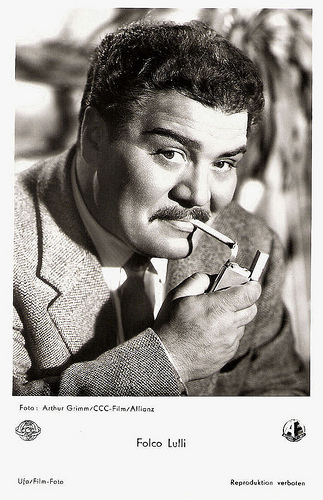
German postcard by Ufa, Berlin-Tempelhof, no. FK 1458. Photo: Arthur Grimm / CCC-Film / Allianz. Publicity still for Stern von Rio/Star from Rio (Kurt Neumann, 1955).
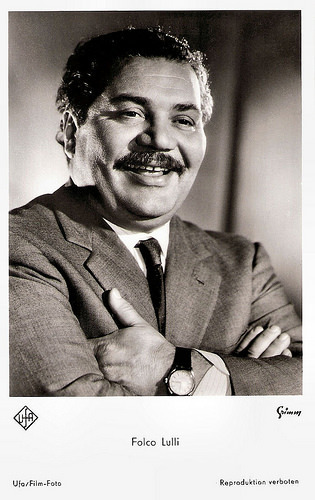
German postcard by Ufa, Berlin-Tempelhof, no. FK 4222. Photo: Arthur Grimm.
Anti-fascist partisan
Folco Lulli was born Florence, Italy, in 1912. He was the son of baritone Gino Lulli and Ada Toccafondi. His brother was actor Piero Lulli.
Folco studied and got degrees in law and philosophy. In 1935 he commanded a group of Ethiopians during the conquest of Abyssinia, where he developed his anti-fascist ideology.
During World War II, he fought with anti-fascist partisans against the Nazis. From September 1943 on, he fought in the brigade I Gruppo Divisioni Alpine, commanded by Enrico Martini. Lulli was captured by the Nazis, and deported in Germany. He escaped and after the war he returned from the Soviet Union to Italy.
In 1946, he was discovered for the screen by filmmaker Alberto Lattuada, who directed him in the crime drama Il bandito/The Bandit (Alberto Lattuada, 1946), starring Anna Magnani and Amedeo Nazzari . Lulli then appeared in Lattuada’s Il delitto di Giovanni Episcopo/Flesh will surrender (Alberto Lattuada, 1947), featuring Aldo Fabrizi.
He also appeared in a supporting part in the Neorealist drama Caccia tragica/The Tragic Pursuit (Giuseppe De Santis, 1947), starring Vivi Gioi and Andrea Checchi . The film was awarded with the First Prize at Film Festival of Venice as 'The Best Italian Film of the Year'.
Lulli played his first leading role in the crime drama Fuga in Francia/Flight Into France (Mario Soldati, 1948). He also appeared in Senza pietà/Without Pity (Alberto Lattuada, 1948), starring Carla del Poggio , and the Totò comedy Totò cerca casa/Totò Looks for an Apartment (Mario Monicelli, Steno, 1949).
He reunited with Giuseppe De Santis for the Neorealist drama Non c'è pace tra gli ulivi/No Peace Under the Olive Tree (Giuseppe De Santis, 1950), starring Raf Vallone and Lucia Bosé . It was filmed on natural locations in the mountains of Ciociaria, the homeland of De Santis.
The next year, Lulli appeared in a supporting part in the classic Luci del varietà/Variety Lights (Alberto Lattuada, Federico Fellini, 1951) about a provincial vaudeville troupe, headed by Peppino De Filippo .

German postcard by Ufa, Berlin-Tempelhof, no. FK 1457. Photo: Arthur Grimm / CCC-Film / Allianz. Publicity still for Polikuschka (Carmine Gallone, 1958).

Austrian postcard by Kellner-Fotokarten, Wien, no. 1544. Photo: CCC / Bavaria / Arthur Grimm. Publicity still for Polikuschka/Polikuska (Carmine Gallone, 1958).
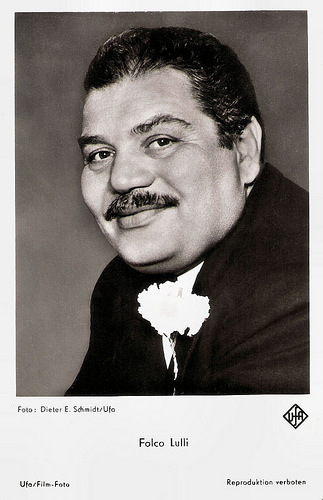
German postcard by Ufa, Berlin-Tempelhof, no. FK 4140. Photo: Dieter E. Schmidt / Ufa.
A cat-and-mouse game with death
Folco Lulli had his international breakthrough with the thriller La Salaire de la Peur/Wages of Fear (Henri-Georges Clouzot, 1953), starring Yves Montand , Charles Vanel and Peter van Eyck . They play four men in a decrepit South American village, who are hired to transport an urgent nitroglycerin shipment without the equipment that would make it safe.
Howard Schumann at IMDb : "This unlikely group will play a cat-and-mouse game with death for the remainder of the film. Clouzot depicts several incidents that bring the tension to the boiling point." La Salaire de la Peur won the Grand Prix at the Cannes Festival.
From then on Lulli appeared in both Italian and such international co-productions as the biblical epic Ester e il re/Esther and the King (Raoul Walsh, 1960) featuring Joan Collins , and I Tartari/The Tartars (Richarde Thorpe, 1961) starring Victor Mature and Orson Welles .
Successful Italian films were the war comedy La grande guerra/The Great War (Mario Monicelli, 1959) with Alberto Sordi and Vittorio Gassman , and L'armata Brancaleone/For Love and Gold (Mario Monicelli, 1966) with Vittorio Gassman and Catherine Spaak .
He won the Nastro d'argento award by the Italian National Union of Film Journalists for his role in I Compagni/The Organizer (Mario Monicelli, 1963). All three films were directed by Mario Monicelli and written by the duo Age & Scarpelli.
Lulli played the president of Latin American country in the hilarious comedy-thriller Le Grand Restaurant/The Big Restaurant (Jacques Besnard, 1966), starring Louis de Funès and Bernard Blier . In 1967 he wrote, scripted and directed a film about the Mafia, Gente d‘onore/Honored People (Folco Lulli, 1967) with Leopoldo Trieste.
Folco Lulli suffered from diabetes and respiratory difficulties. He died of a heart attack in 1970 in a hospital in Rome. He was 57. His final film, the comedy Tre nel mille/Three in a thousand (Franco Indovina, 1971), was released after his death.
Scene from Caccia tragica/The Tragic Pursuit (1947). Source: borgorusky (YouTube).
Trailer La Salaire de la Peur/Wages of Fear (1953). Source: neondreams 25 (YouTube).
German trailer for Der Mörder mit dem Seidenschal/The Murderer with the Silk Scarf (Adrian Hoven, 1966). Source: Italo-Cinema Trailer (YouTube). Sorry, no subtitles!
Sources: Hal Erickson (AllMovie), Find A Grave, Wikipedia (English, French and Italian), and .

German postcard by Ufa, Berlin-Tempelhof, no. FK 1458. Photo: Arthur Grimm / CCC-Film / Allianz. Publicity still for Stern von Rio/Star from Rio (Kurt Neumann, 1955).

German postcard by Ufa, Berlin-Tempelhof, no. FK 4222. Photo: Arthur Grimm.
Anti-fascist partisan
Folco Lulli was born Florence, Italy, in 1912. He was the son of baritone Gino Lulli and Ada Toccafondi. His brother was actor Piero Lulli.
Folco studied and got degrees in law and philosophy. In 1935 he commanded a group of Ethiopians during the conquest of Abyssinia, where he developed his anti-fascist ideology.
During World War II, he fought with anti-fascist partisans against the Nazis. From September 1943 on, he fought in the brigade I Gruppo Divisioni Alpine, commanded by Enrico Martini. Lulli was captured by the Nazis, and deported in Germany. He escaped and after the war he returned from the Soviet Union to Italy.
In 1946, he was discovered for the screen by filmmaker Alberto Lattuada, who directed him in the crime drama Il bandito/The Bandit (Alberto Lattuada, 1946), starring Anna Magnani and Amedeo Nazzari . Lulli then appeared in Lattuada’s Il delitto di Giovanni Episcopo/Flesh will surrender (Alberto Lattuada, 1947), featuring Aldo Fabrizi.
He also appeared in a supporting part in the Neorealist drama Caccia tragica/The Tragic Pursuit (Giuseppe De Santis, 1947), starring Vivi Gioi and Andrea Checchi . The film was awarded with the First Prize at Film Festival of Venice as 'The Best Italian Film of the Year'.
Lulli played his first leading role in the crime drama Fuga in Francia/Flight Into France (Mario Soldati, 1948). He also appeared in Senza pietà/Without Pity (Alberto Lattuada, 1948), starring Carla del Poggio , and the Totò comedy Totò cerca casa/Totò Looks for an Apartment (Mario Monicelli, Steno, 1949).
He reunited with Giuseppe De Santis for the Neorealist drama Non c'è pace tra gli ulivi/No Peace Under the Olive Tree (Giuseppe De Santis, 1950), starring Raf Vallone and Lucia Bosé . It was filmed on natural locations in the mountains of Ciociaria, the homeland of De Santis.
The next year, Lulli appeared in a supporting part in the classic Luci del varietà/Variety Lights (Alberto Lattuada, Federico Fellini, 1951) about a provincial vaudeville troupe, headed by Peppino De Filippo .

German postcard by Ufa, Berlin-Tempelhof, no. FK 1457. Photo: Arthur Grimm / CCC-Film / Allianz. Publicity still for Polikuschka (Carmine Gallone, 1958).

Austrian postcard by Kellner-Fotokarten, Wien, no. 1544. Photo: CCC / Bavaria / Arthur Grimm. Publicity still for Polikuschka/Polikuska (Carmine Gallone, 1958).

German postcard by Ufa, Berlin-Tempelhof, no. FK 4140. Photo: Dieter E. Schmidt / Ufa.
A cat-and-mouse game with death
Folco Lulli had his international breakthrough with the thriller La Salaire de la Peur/Wages of Fear (Henri-Georges Clouzot, 1953), starring Yves Montand , Charles Vanel and Peter van Eyck . They play four men in a decrepit South American village, who are hired to transport an urgent nitroglycerin shipment without the equipment that would make it safe.
Howard Schumann at IMDb : "This unlikely group will play a cat-and-mouse game with death for the remainder of the film. Clouzot depicts several incidents that bring the tension to the boiling point." La Salaire de la Peur won the Grand Prix at the Cannes Festival.
From then on Lulli appeared in both Italian and such international co-productions as the biblical epic Ester e il re/Esther and the King (Raoul Walsh, 1960) featuring Joan Collins , and I Tartari/The Tartars (Richarde Thorpe, 1961) starring Victor Mature and Orson Welles .
Successful Italian films were the war comedy La grande guerra/The Great War (Mario Monicelli, 1959) with Alberto Sordi and Vittorio Gassman , and L'armata Brancaleone/For Love and Gold (Mario Monicelli, 1966) with Vittorio Gassman and Catherine Spaak .
He won the Nastro d'argento award by the Italian National Union of Film Journalists for his role in I Compagni/The Organizer (Mario Monicelli, 1963). All three films were directed by Mario Monicelli and written by the duo Age & Scarpelli.
Lulli played the president of Latin American country in the hilarious comedy-thriller Le Grand Restaurant/The Big Restaurant (Jacques Besnard, 1966), starring Louis de Funès and Bernard Blier . In 1967 he wrote, scripted and directed a film about the Mafia, Gente d‘onore/Honored People (Folco Lulli, 1967) with Leopoldo Trieste.
Folco Lulli suffered from diabetes and respiratory difficulties. He died of a heart attack in 1970 in a hospital in Rome. He was 57. His final film, the comedy Tre nel mille/Three in a thousand (Franco Indovina, 1971), was released after his death.
Scene from Caccia tragica/The Tragic Pursuit (1947). Source: borgorusky (YouTube).
Trailer La Salaire de la Peur/Wages of Fear (1953). Source: neondreams 25 (YouTube).
German trailer for Der Mörder mit dem Seidenschal/The Murderer with the Silk Scarf (Adrian Hoven, 1966). Source: Italo-Cinema Trailer (YouTube). Sorry, no subtitles!
Sources: Hal Erickson (AllMovie), Find A Grave, Wikipedia (English, French and Italian), and .
Published on July 29, 2017 22:00
July 28, 2017
Twelve postcards from Brighton
Last Saturday, we had a post with twelve sunny and glamorous Italian postcards of the 1950s which we acquired during our trip to Italy. Today we like to share twelve new acquisitions we found a week later in Brighton, U.K. in a nice shop called Step Back In Time.

Errol Flynn . British postcard in the Picturegoer Series, London, no. W 65. Photo: Warner Bros.
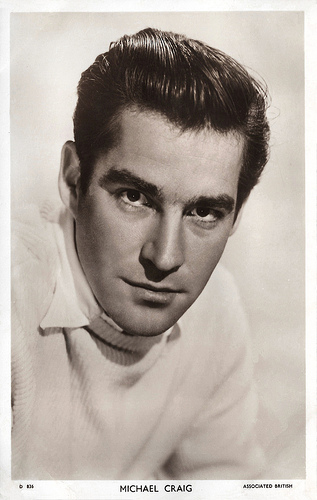
Michael Craig. British postcard in the Picturegoer Series, London, no. D 836. Photo: Associated British.
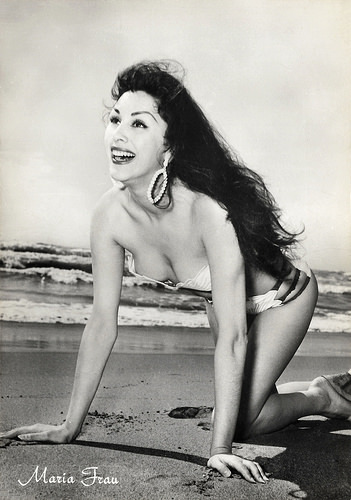
Maria Frau . Italian postcard by Rotalfoto, Milano, no. 578.
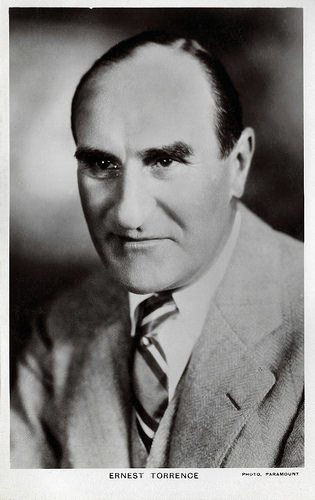
Ernest Torrence. British postcard in the Picturegoer series, London, no. 167a. Photo: Paramount.
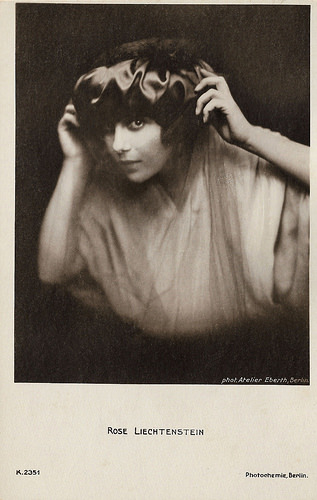
Rose Liechtenstein. German postcard by Photochemie, Berlin, no. K. 2351. Photo: Atelier Eberth, Berlin.
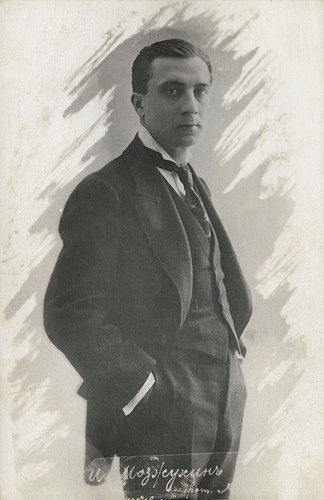
Ivan Mozzhukhin . Russian postcard.

Isobel Elsom. British postcard in the Lilywhite Photographic Series, no. L.E. 1. Photo: Lilywhite.
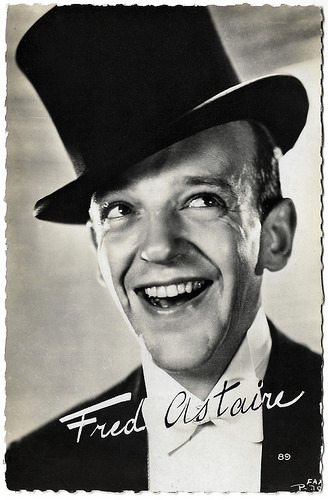
Fred Astaire. French postcard by Editions et Publications Cinematographiques, no. 89.
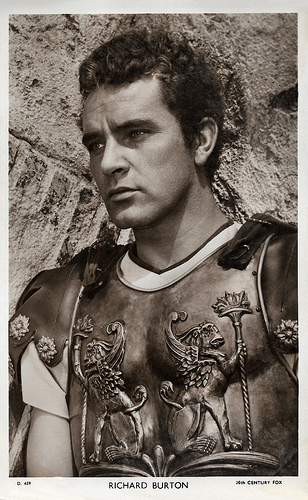
Richard Burton . British postcard in the Picturegoer Series, London, no. D 459. Photo: 20th Century Fox. Publicity still for The Robe (Henry Koster, 1953).
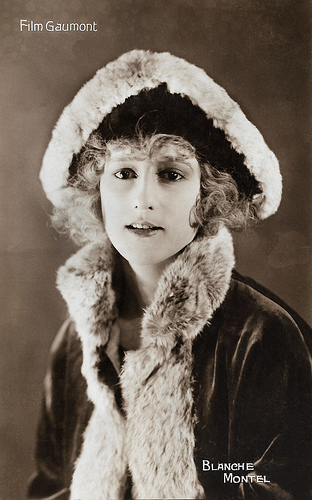
Blanche Montel . French postcard. Photo: Film Gaumont.
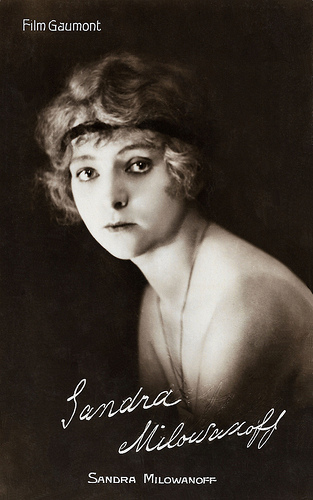
Sandra Milowanoff . French postcard. Photo: Film Gaumont.
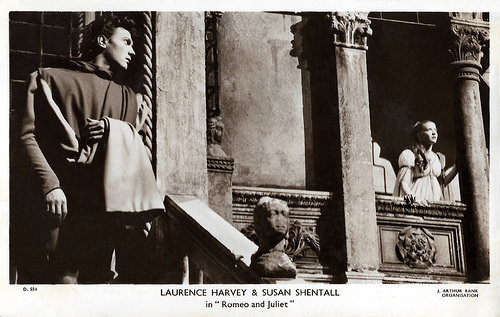
Laurence Harvey and Susan Shentall. British postcard in the Picturegoer Series, London, no. D 551. Photo: J. Arthur Rank Organisation. Publicity still for Romeo and Juliet (Renato Castellani, 1954).

Errol Flynn . British postcard in the Picturegoer Series, London, no. W 65. Photo: Warner Bros.

Michael Craig. British postcard in the Picturegoer Series, London, no. D 836. Photo: Associated British.

Maria Frau . Italian postcard by Rotalfoto, Milano, no. 578.

Ernest Torrence. British postcard in the Picturegoer series, London, no. 167a. Photo: Paramount.

Rose Liechtenstein. German postcard by Photochemie, Berlin, no. K. 2351. Photo: Atelier Eberth, Berlin.

Ivan Mozzhukhin . Russian postcard.

Isobel Elsom. British postcard in the Lilywhite Photographic Series, no. L.E. 1. Photo: Lilywhite.

Fred Astaire. French postcard by Editions et Publications Cinematographiques, no. 89.

Richard Burton . British postcard in the Picturegoer Series, London, no. D 459. Photo: 20th Century Fox. Publicity still for The Robe (Henry Koster, 1953).

Blanche Montel . French postcard. Photo: Film Gaumont.

Sandra Milowanoff . French postcard. Photo: Film Gaumont.

Laurence Harvey and Susan Shentall. British postcard in the Picturegoer Series, London, no. D 551. Photo: J. Arthur Rank Organisation. Publicity still for Romeo and Juliet (Renato Castellani, 1954).
Published on July 28, 2017 22:00
Paul van Yperen's Blog
- Paul van Yperen's profile
- 13 followers
Paul van Yperen isn't a Goodreads Author
(yet),
but they
do have a blog,
so here are some recent posts imported from
their feed.



